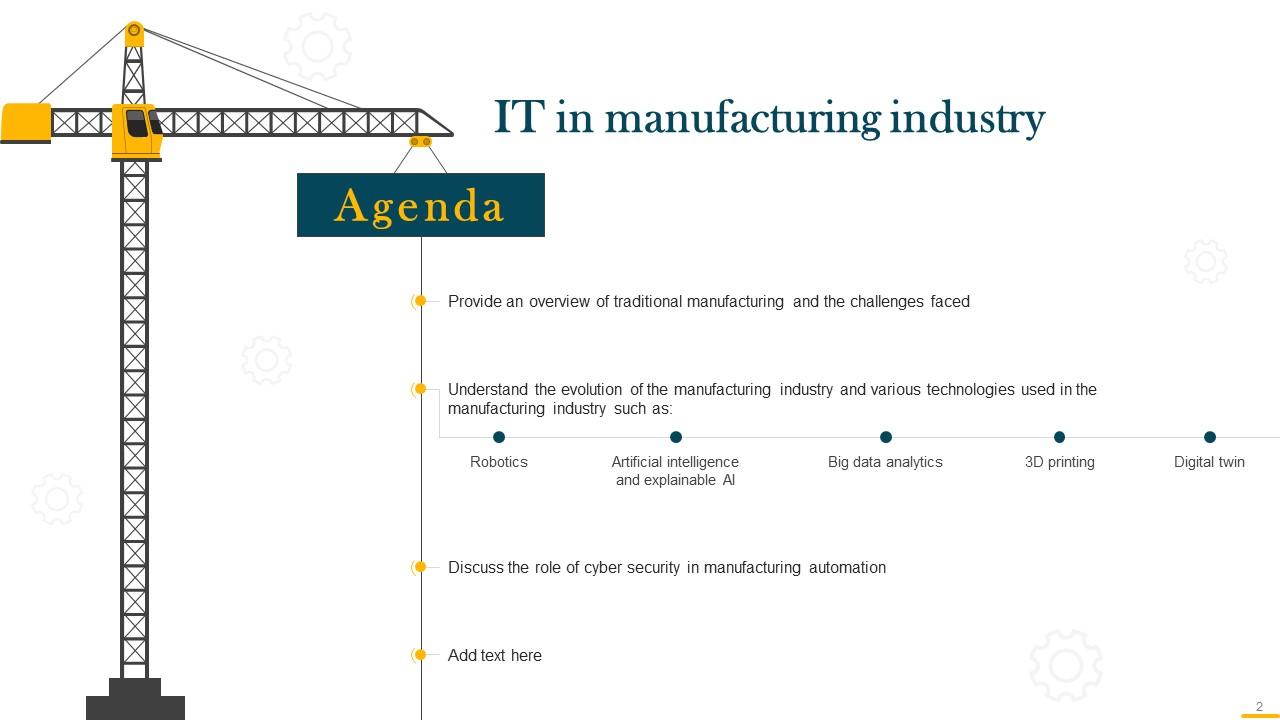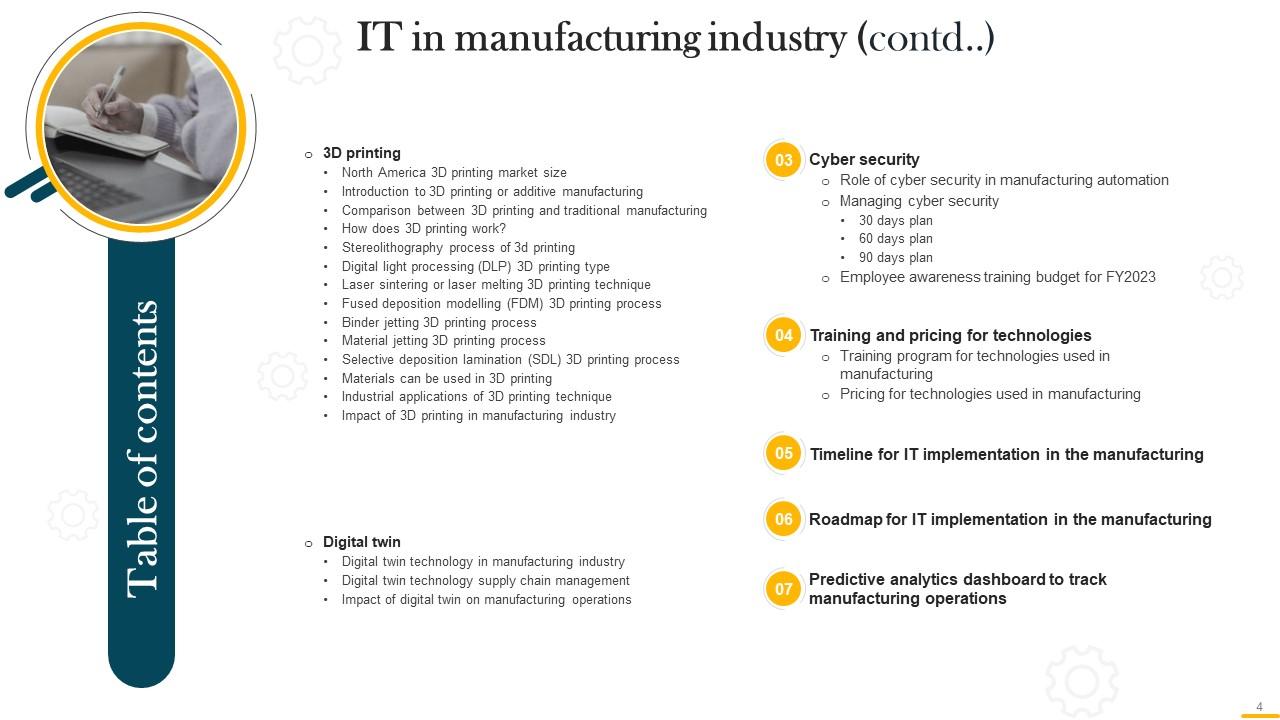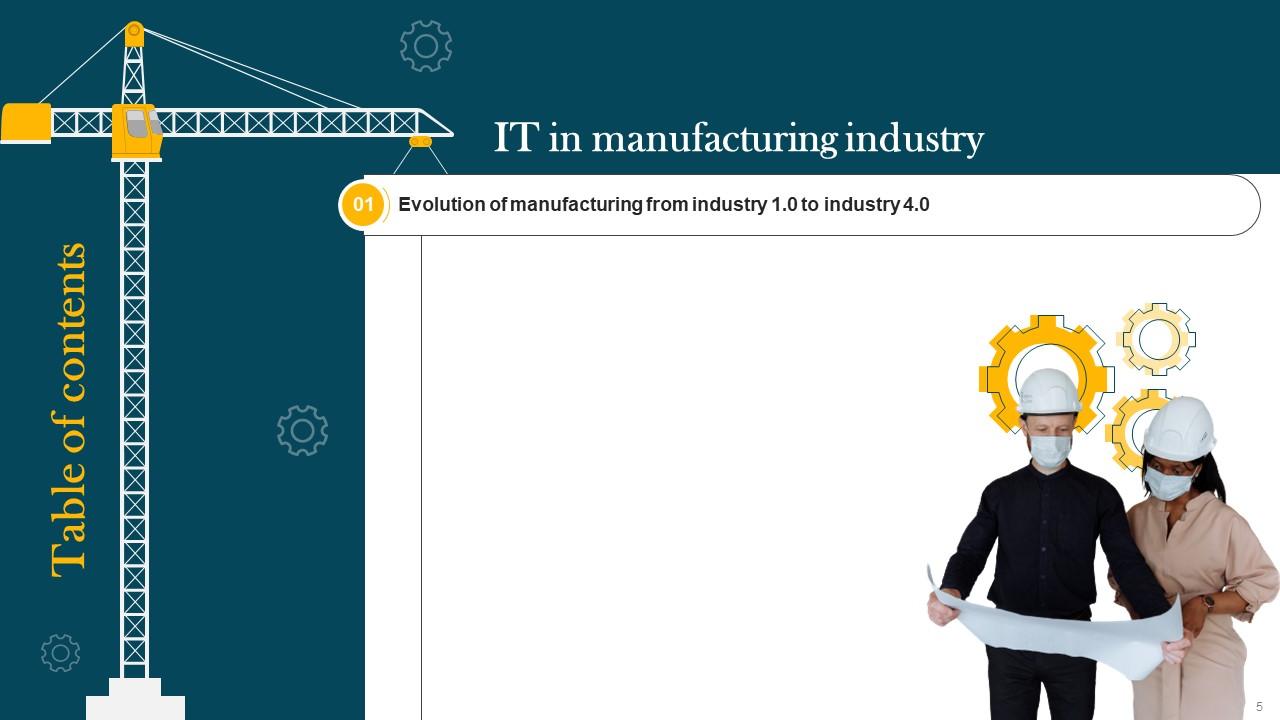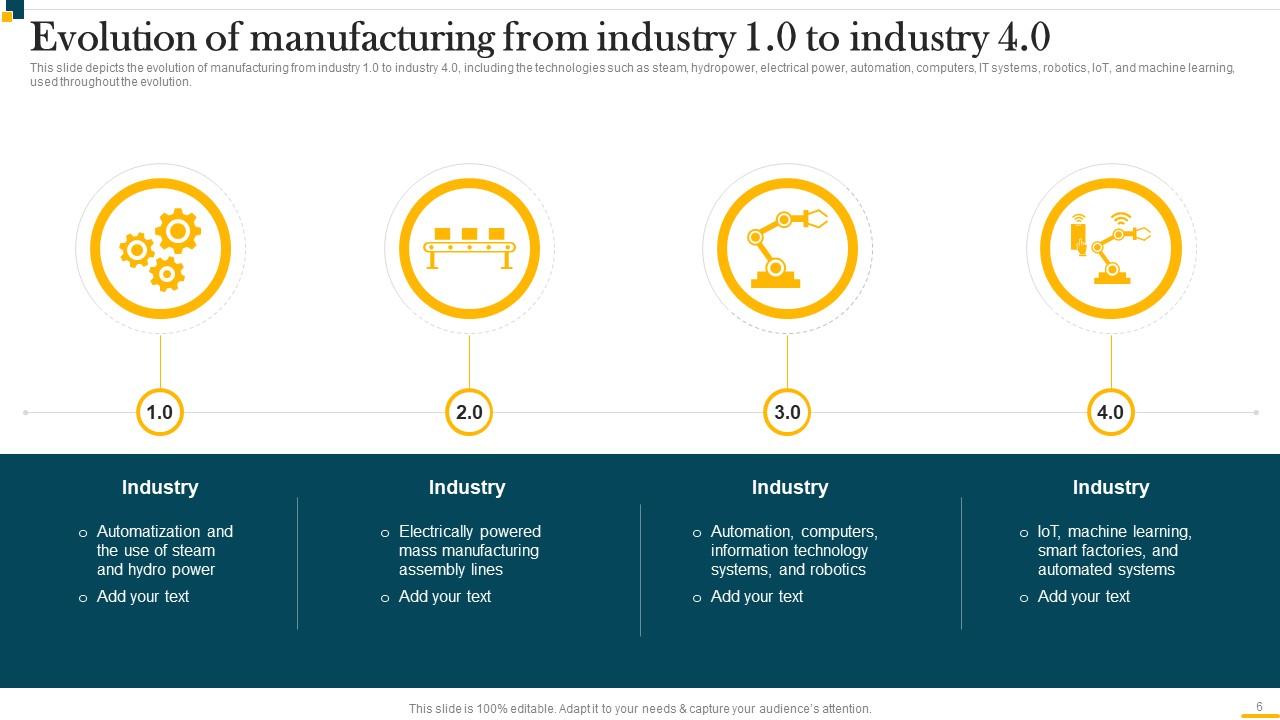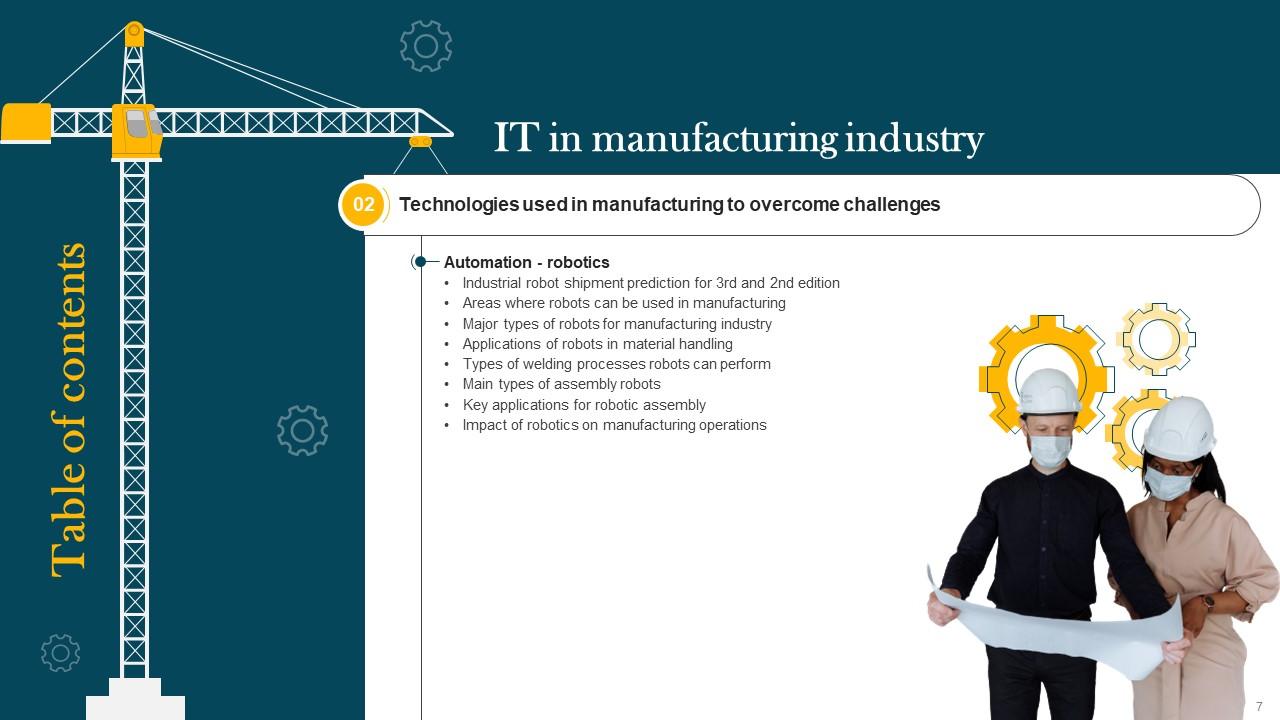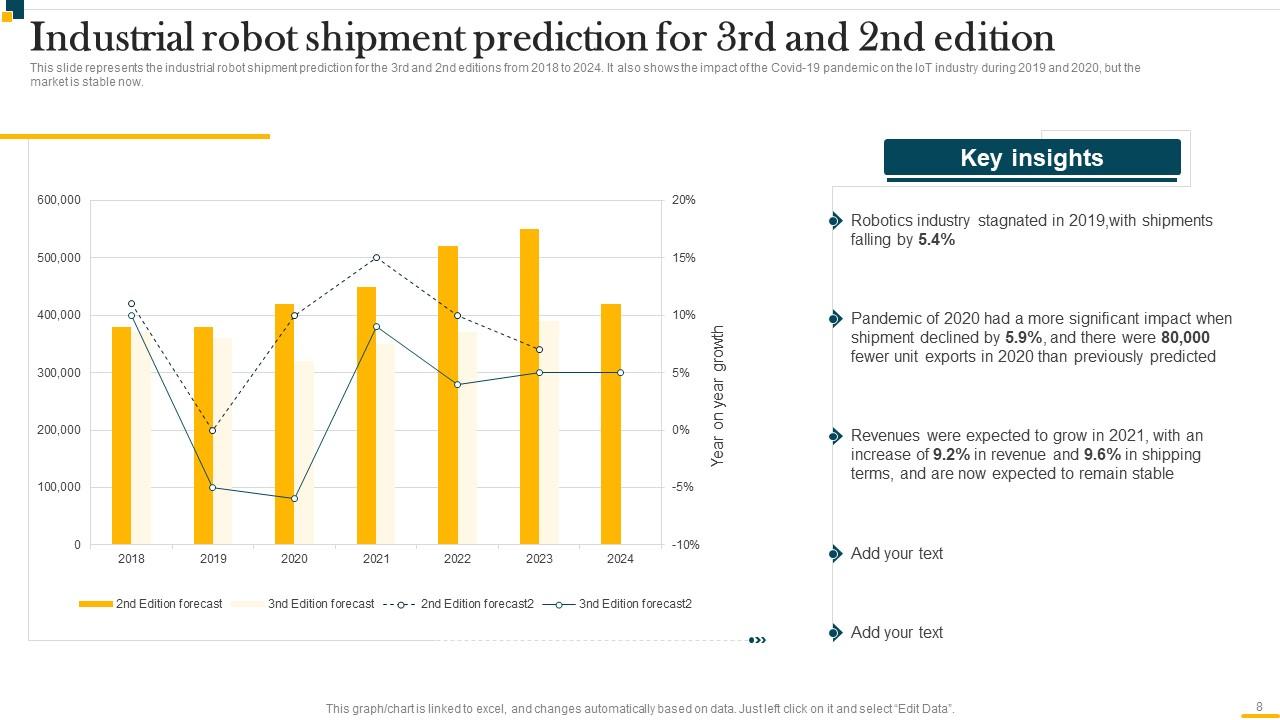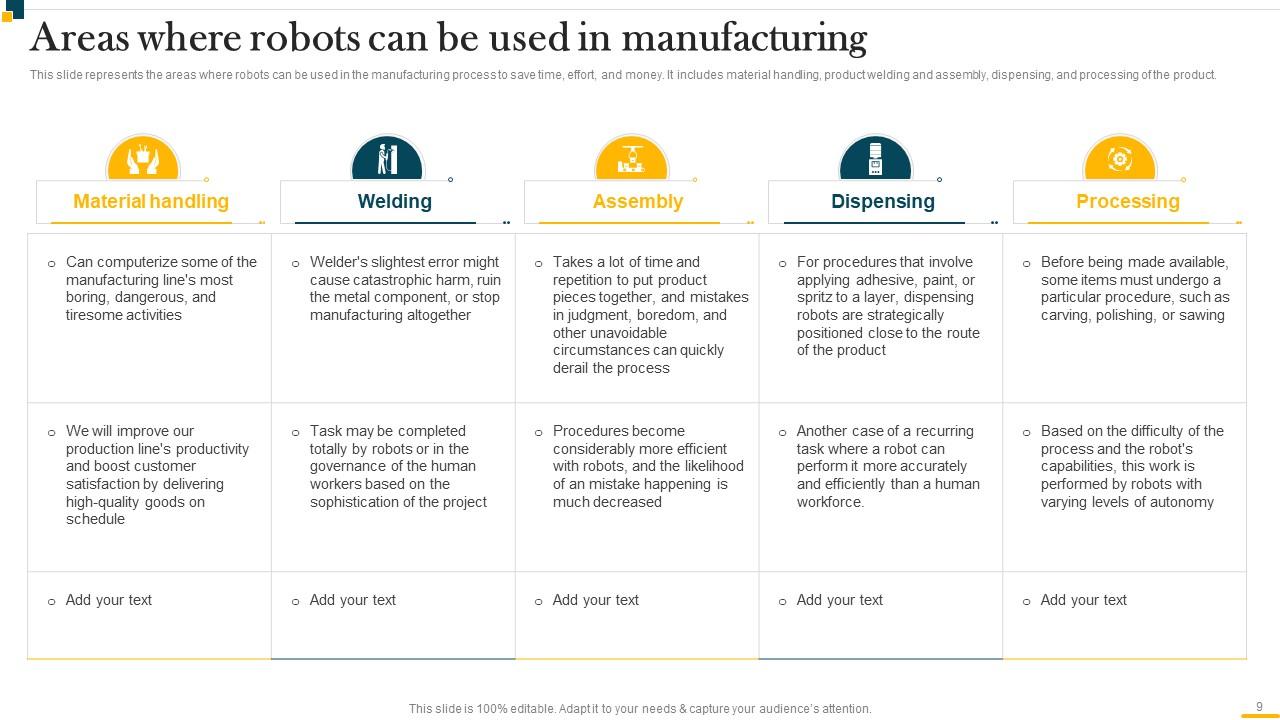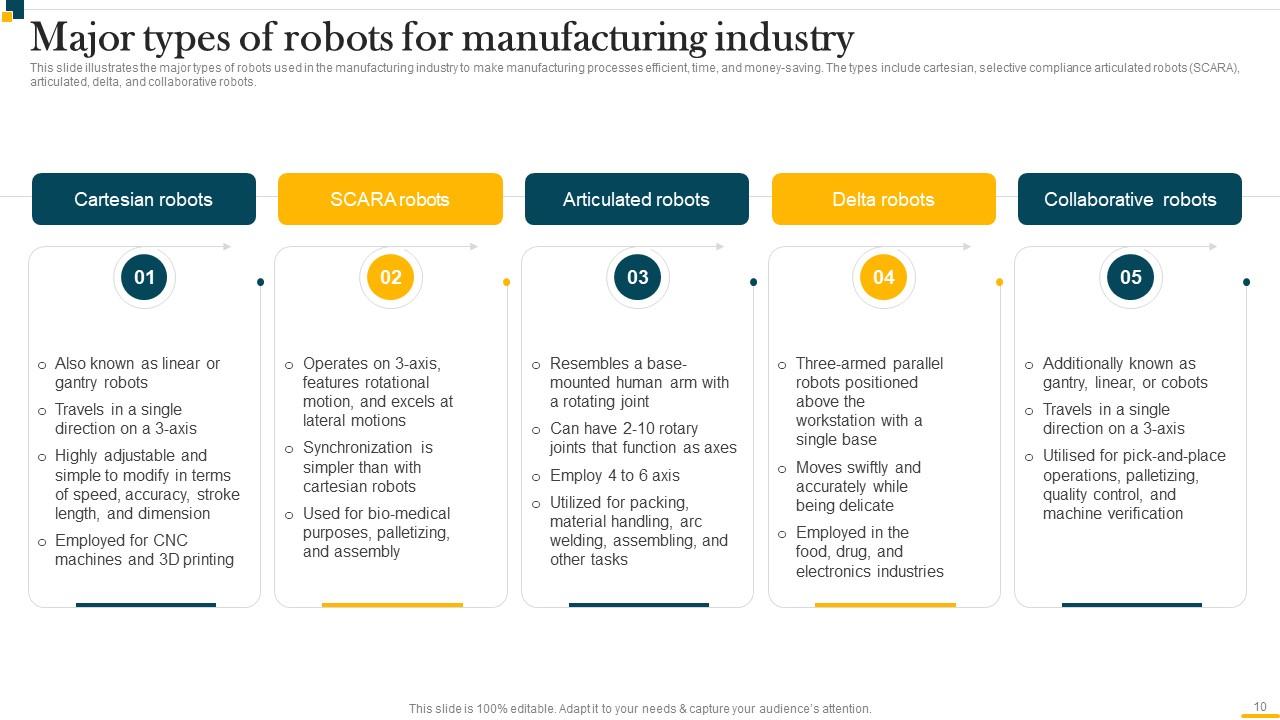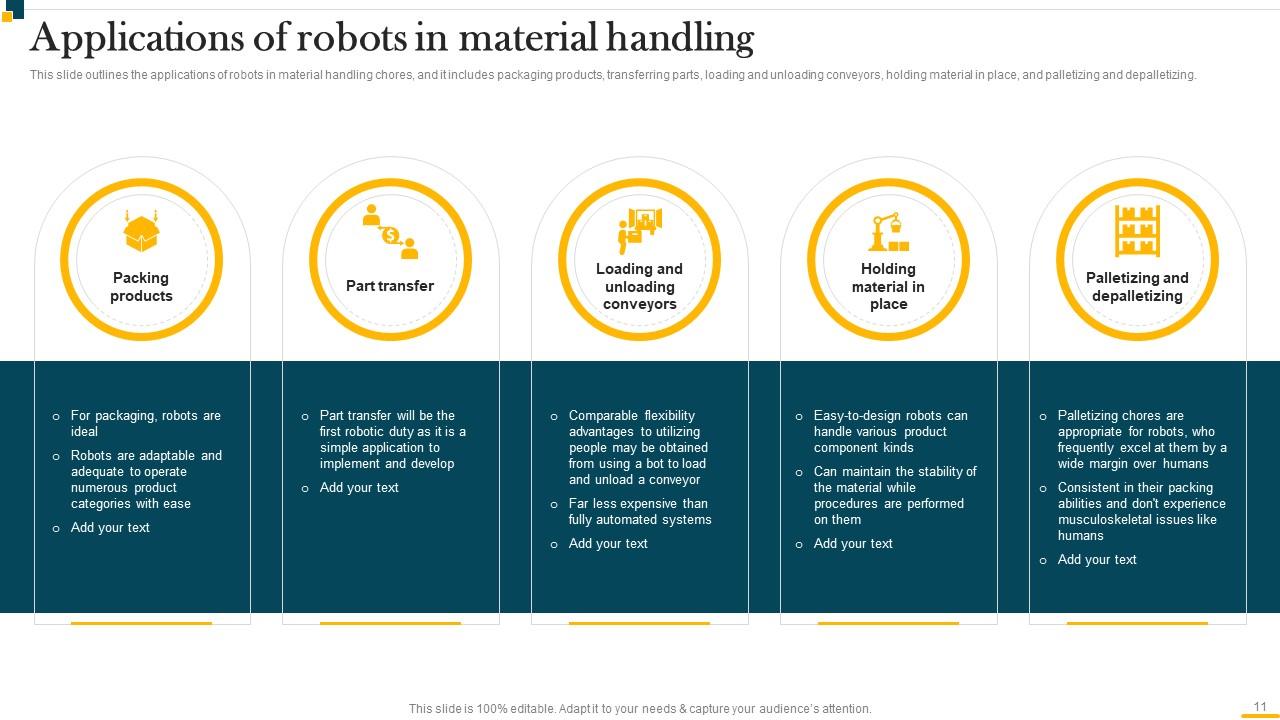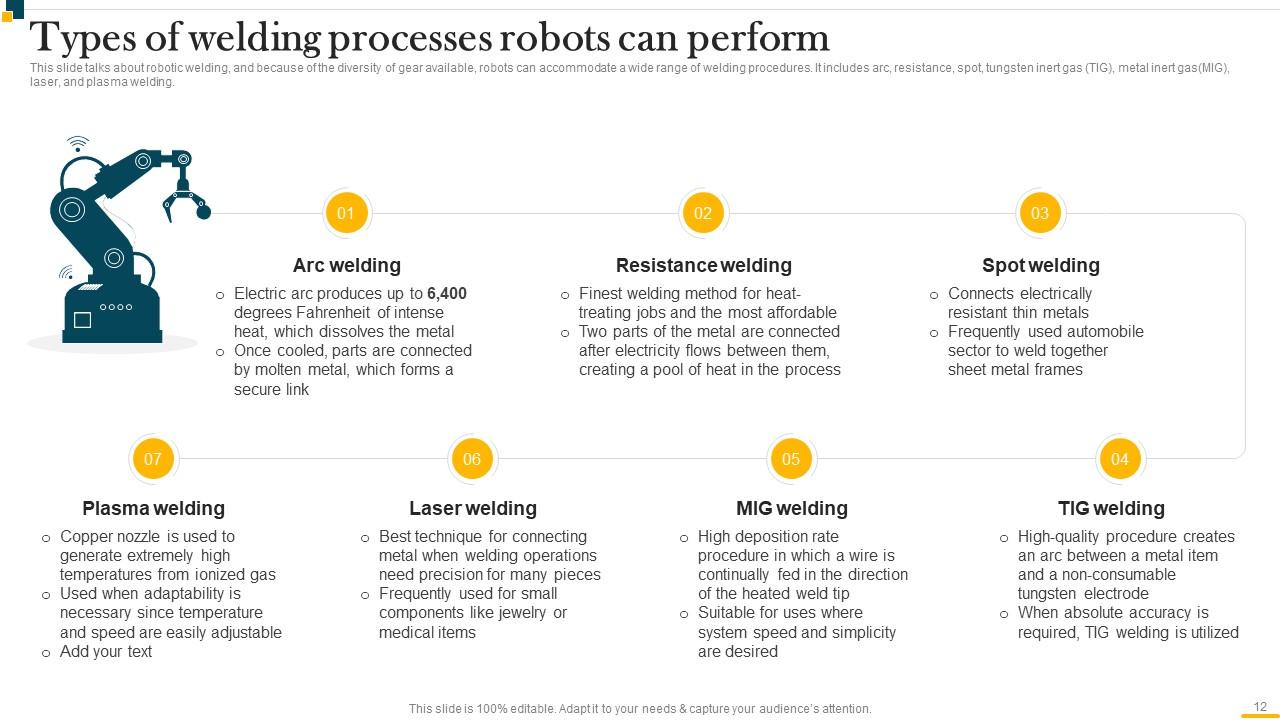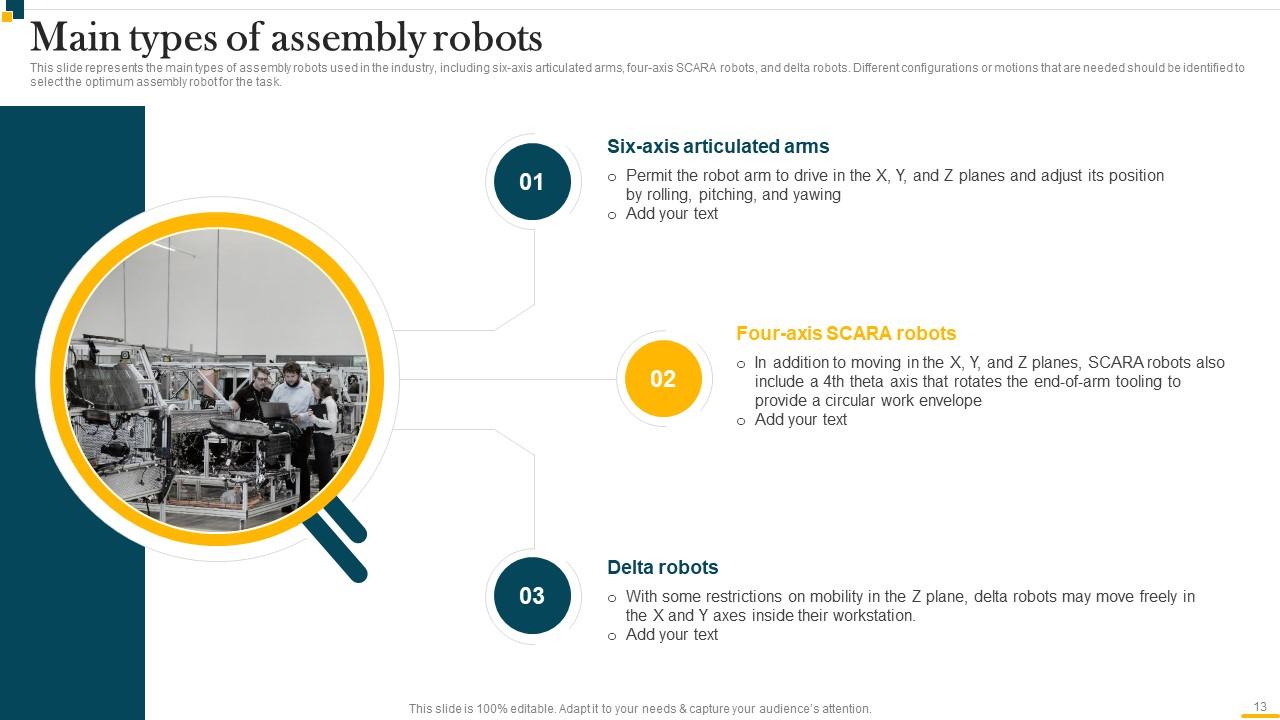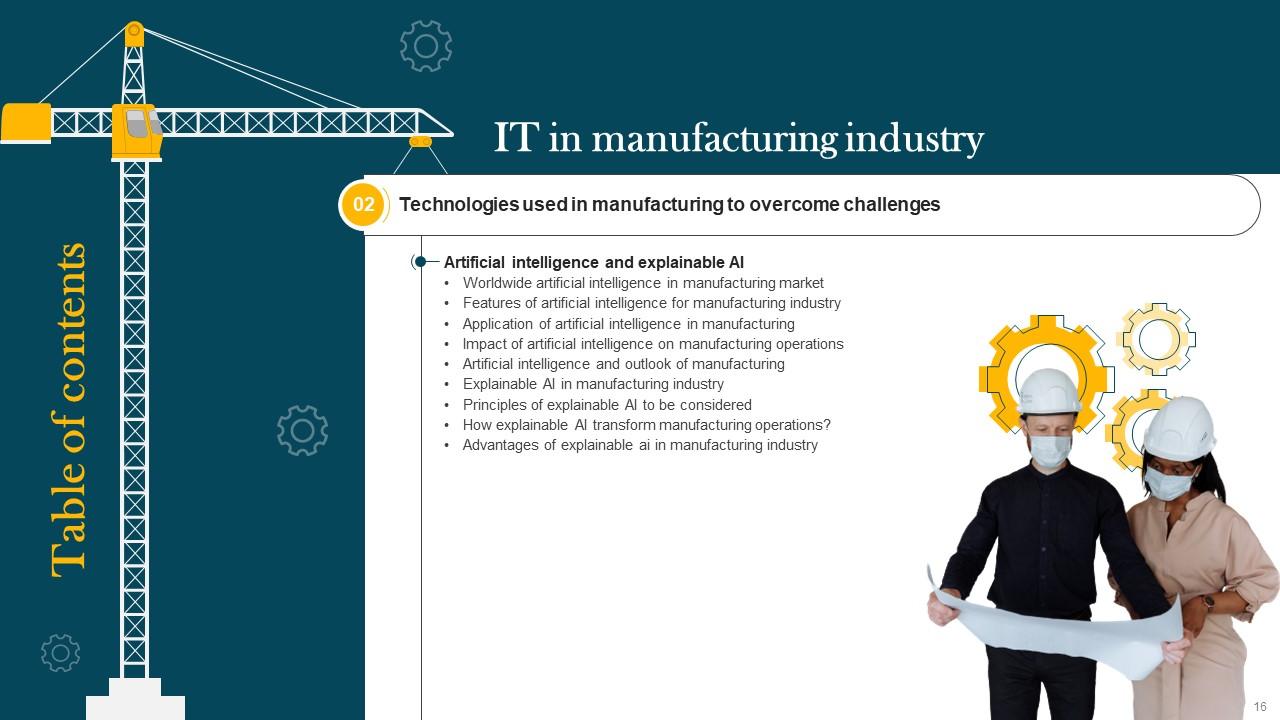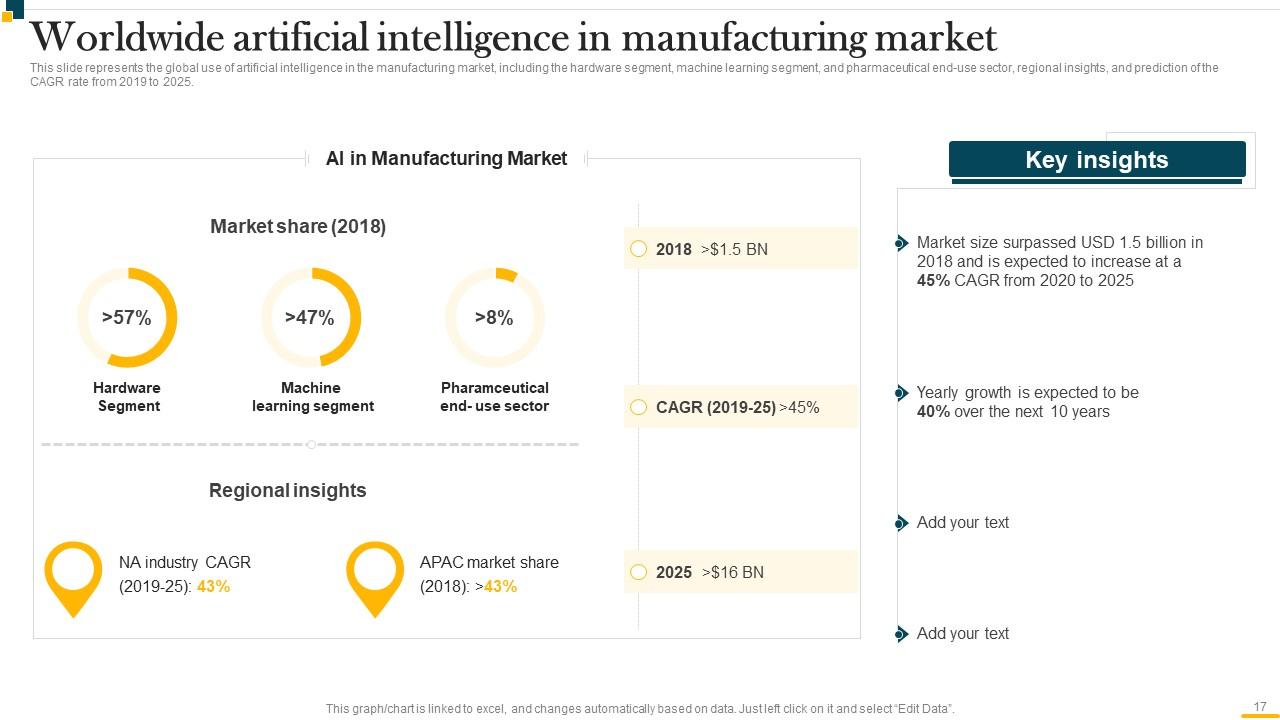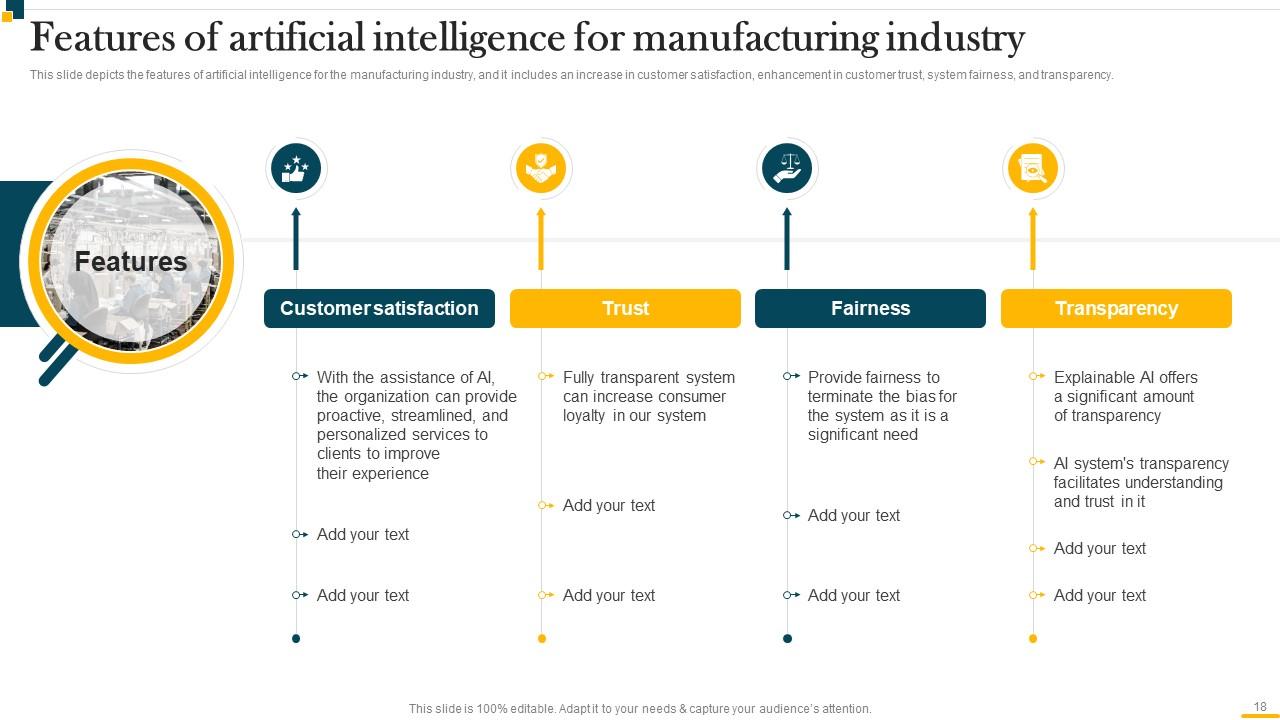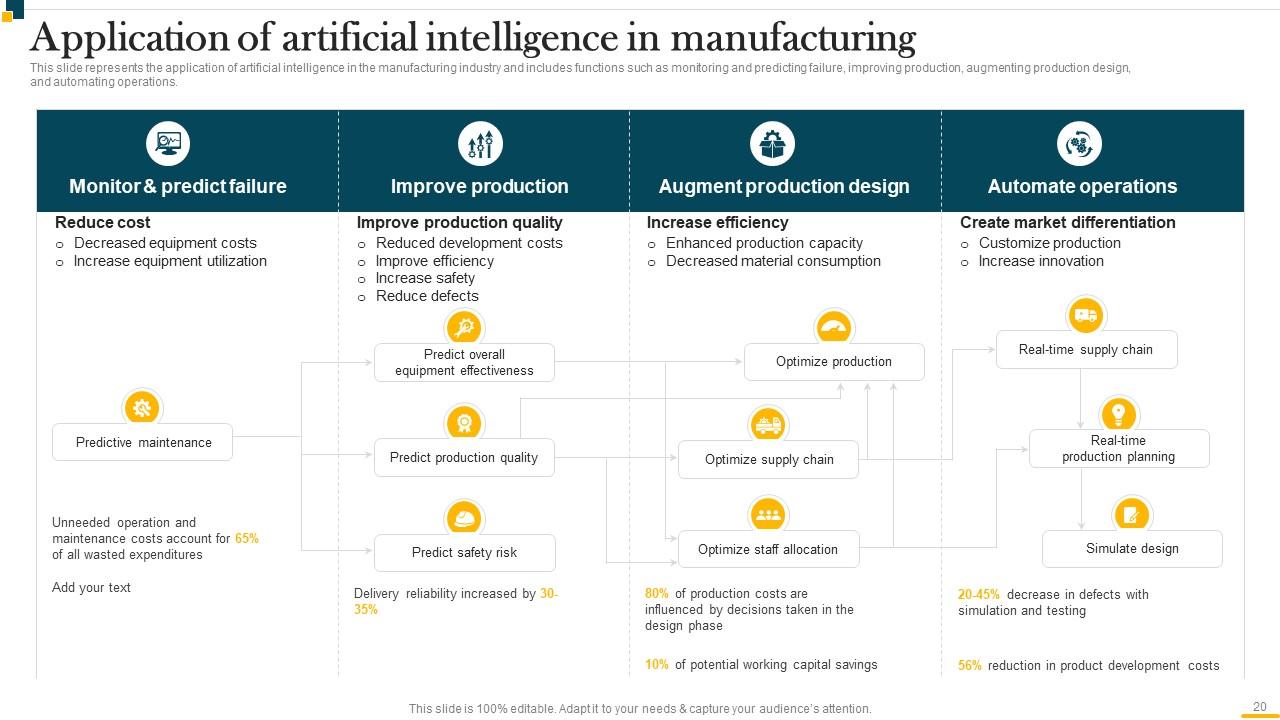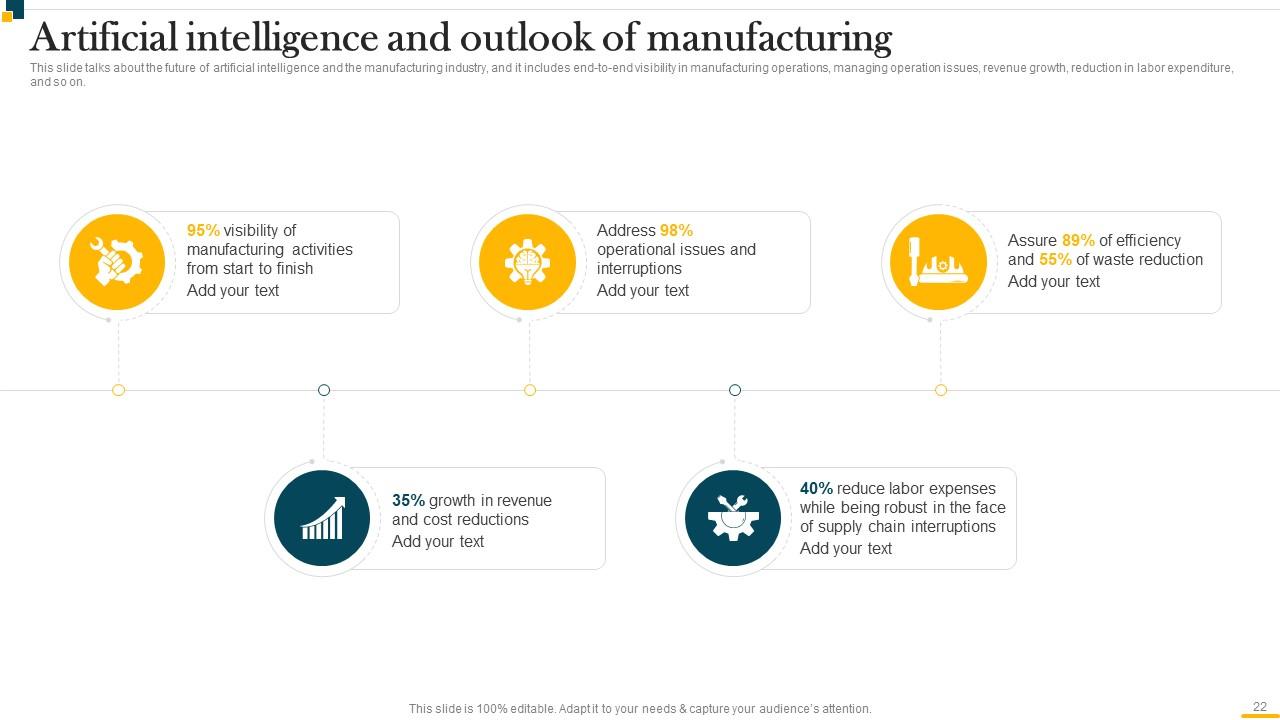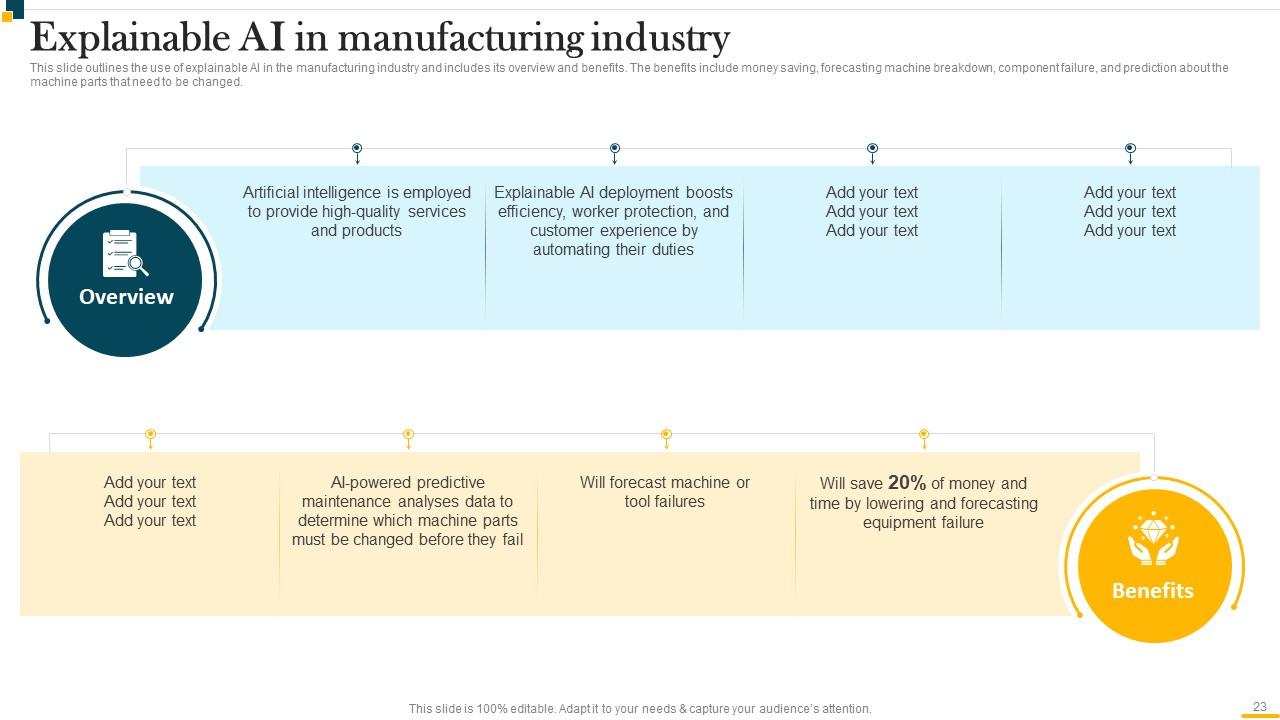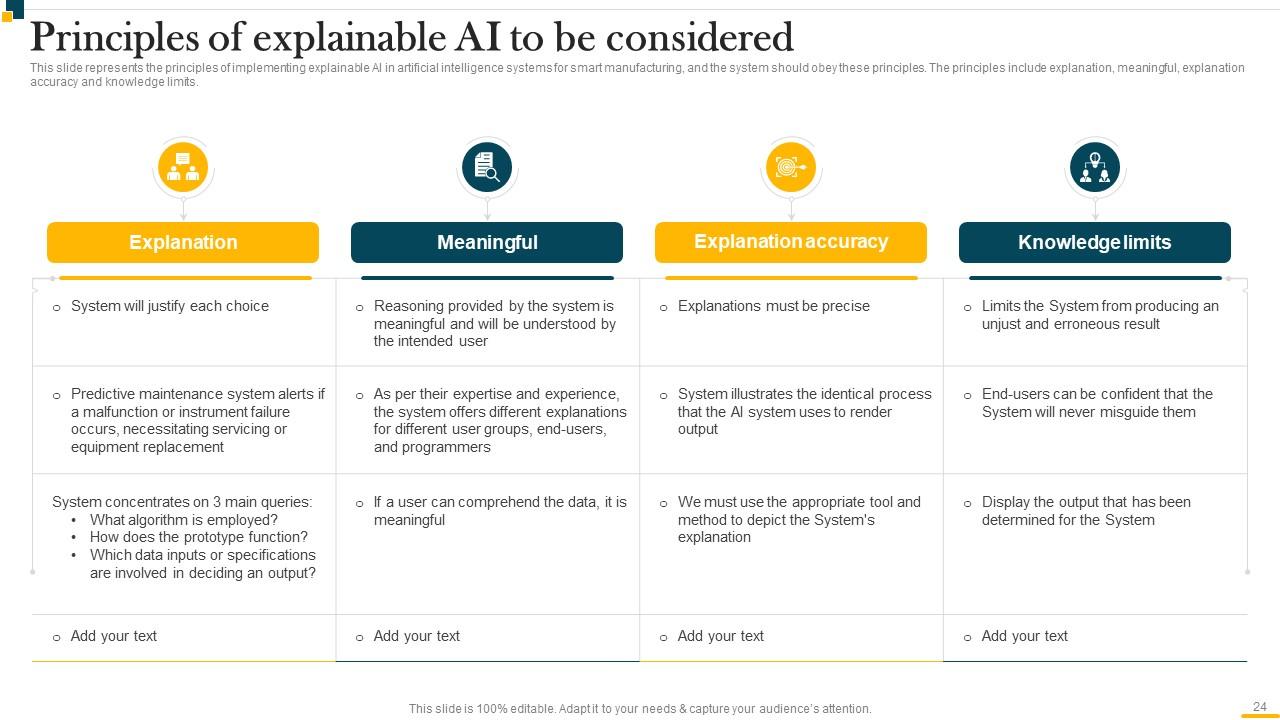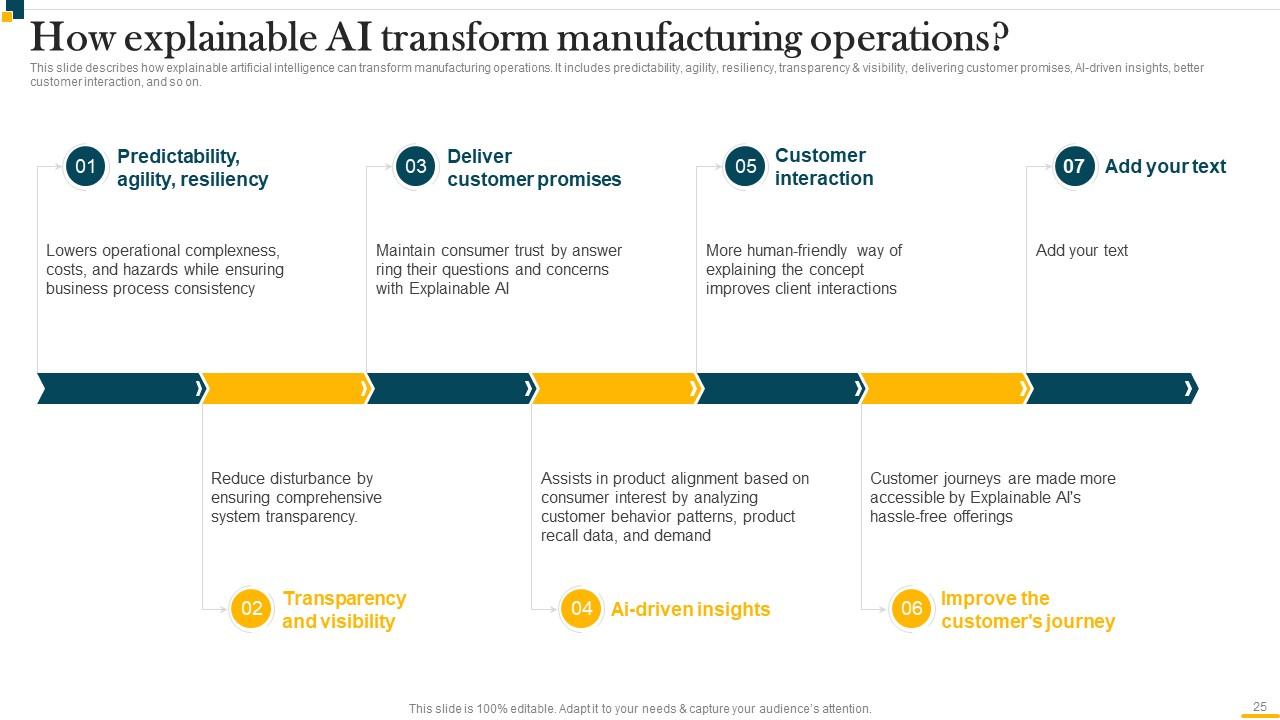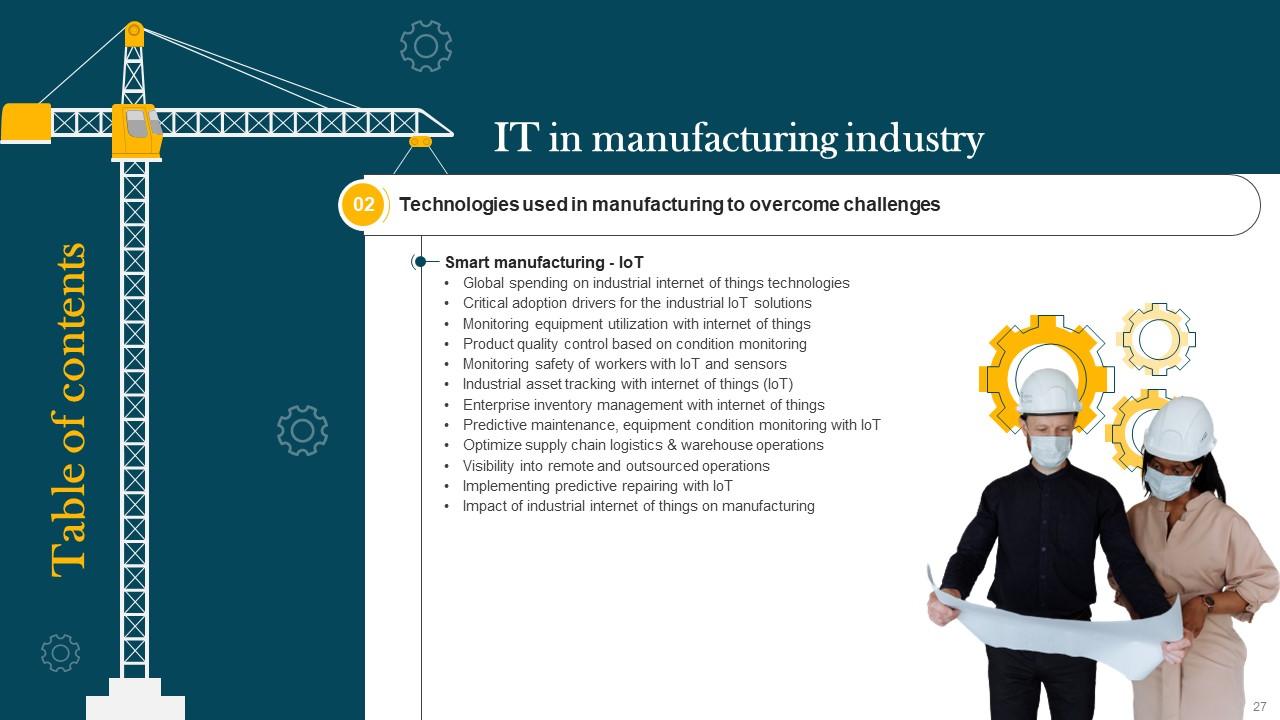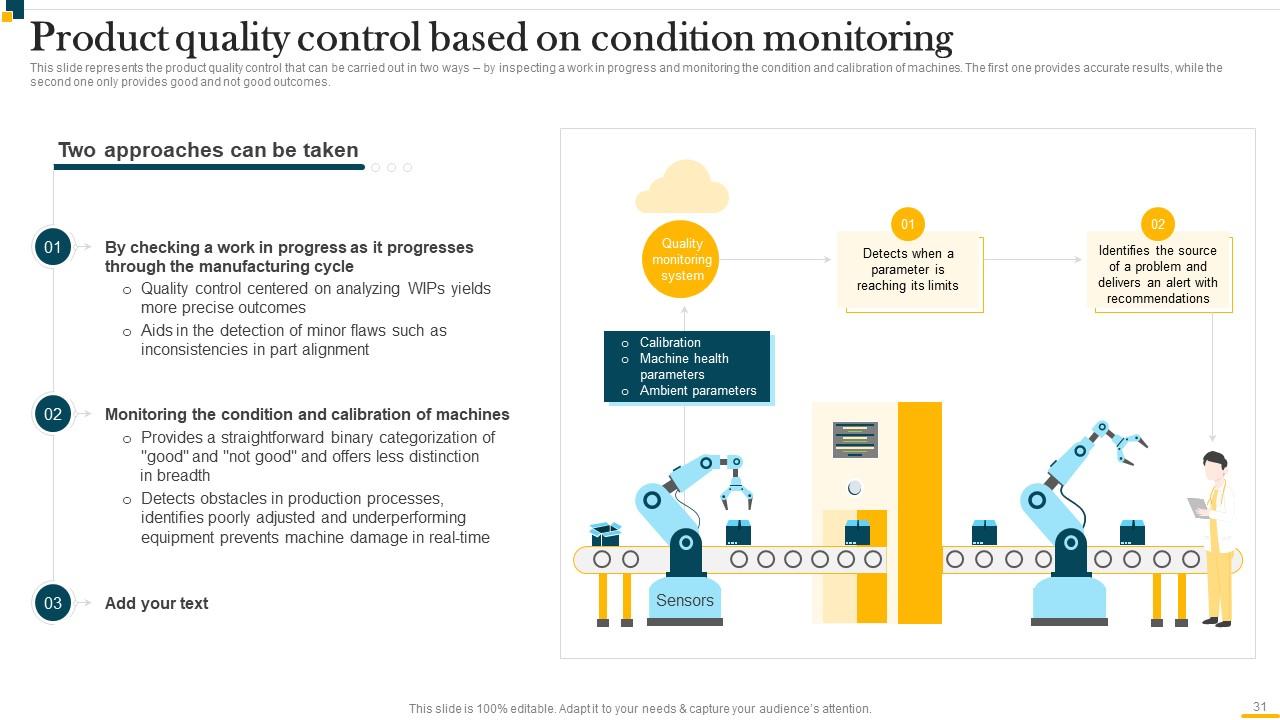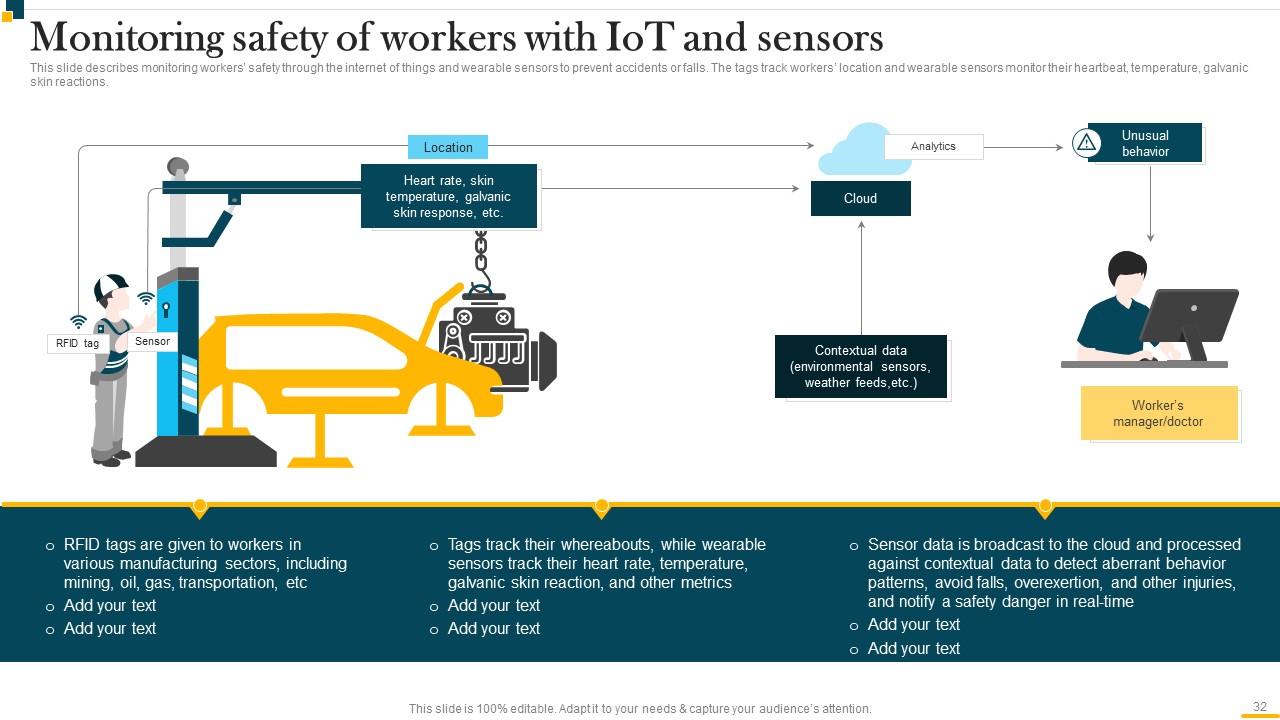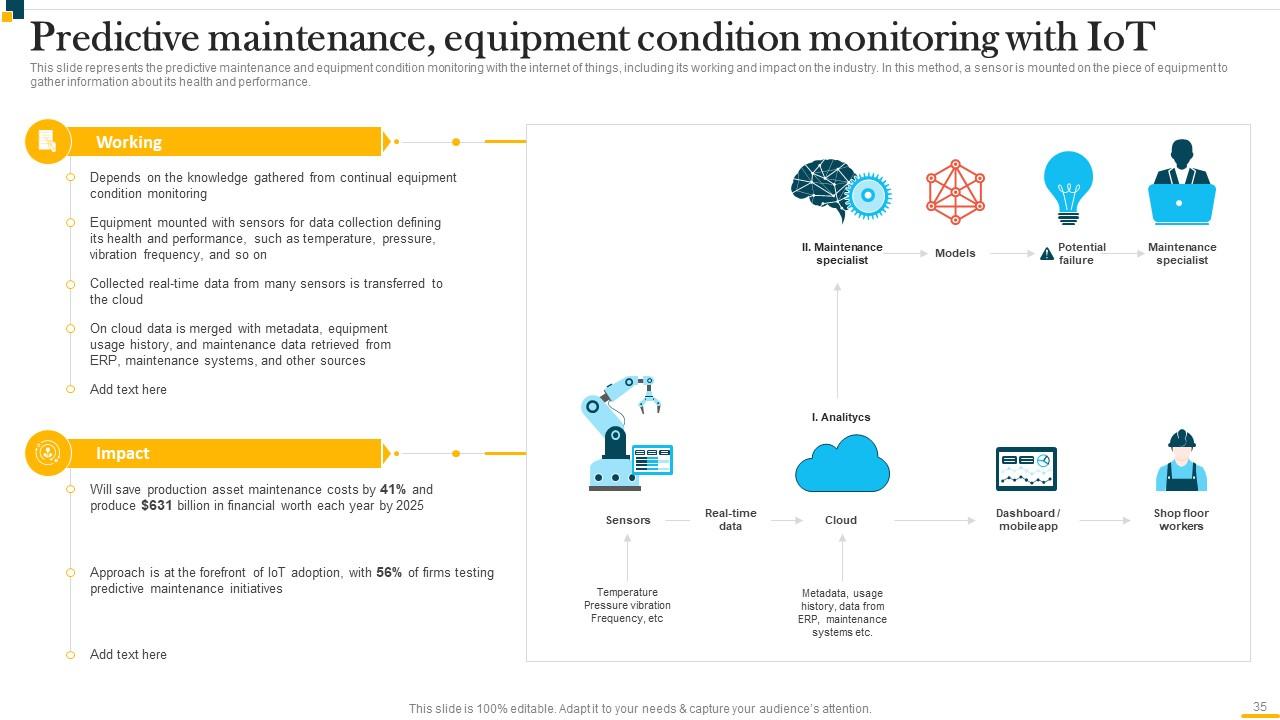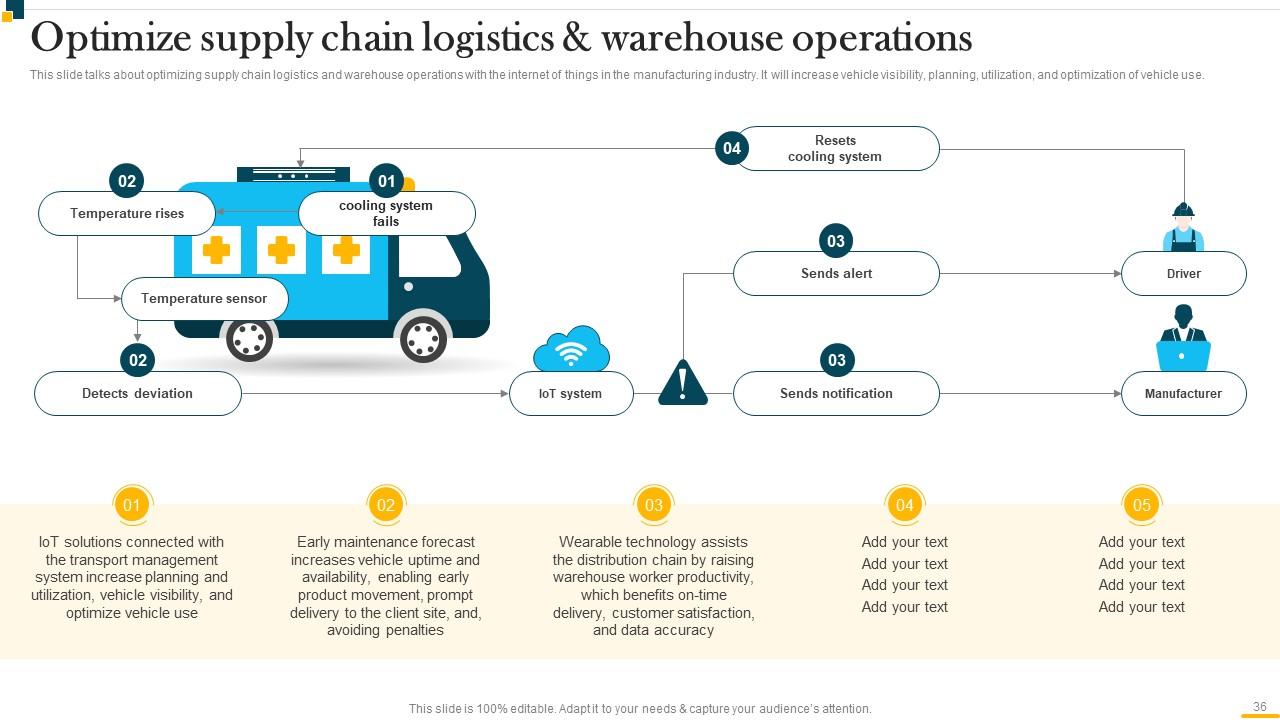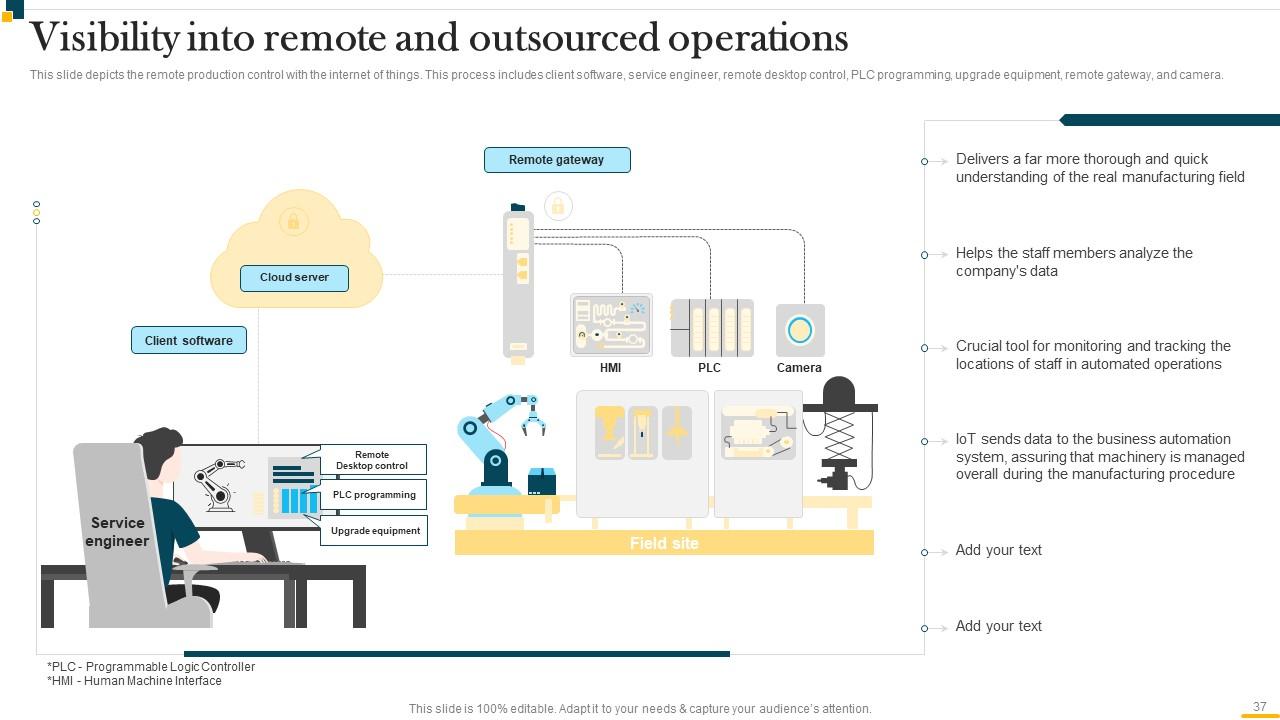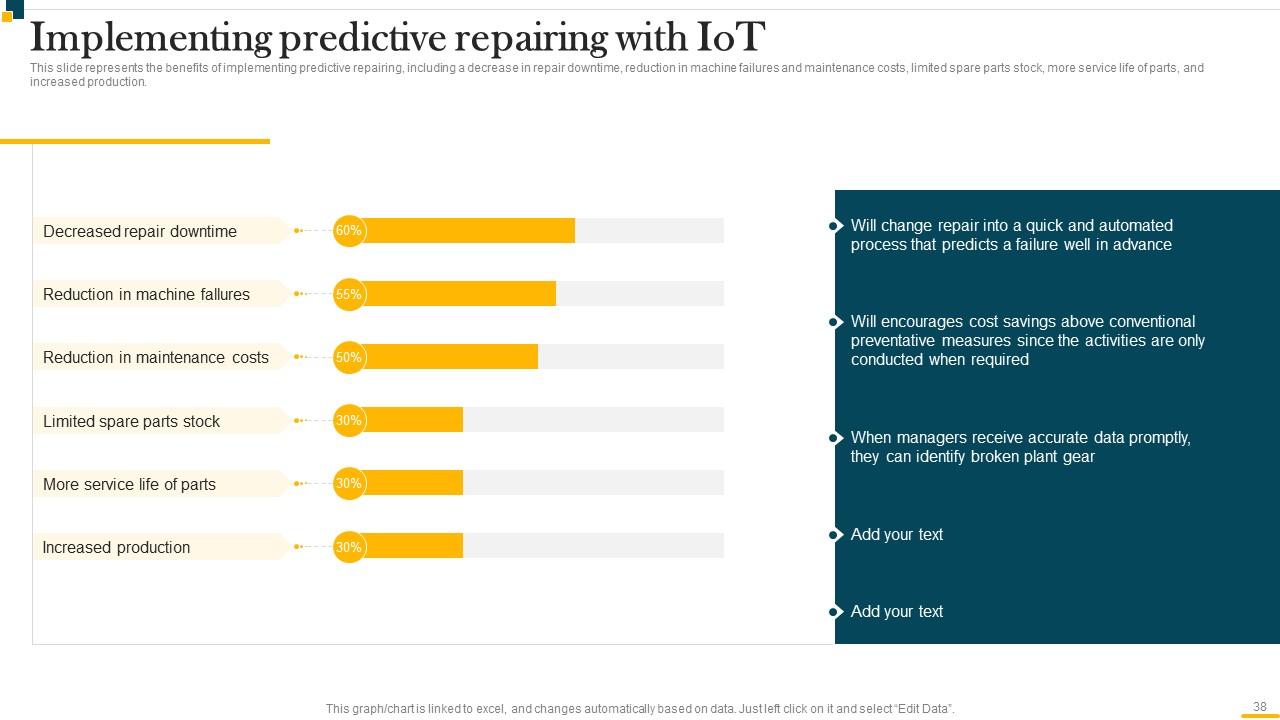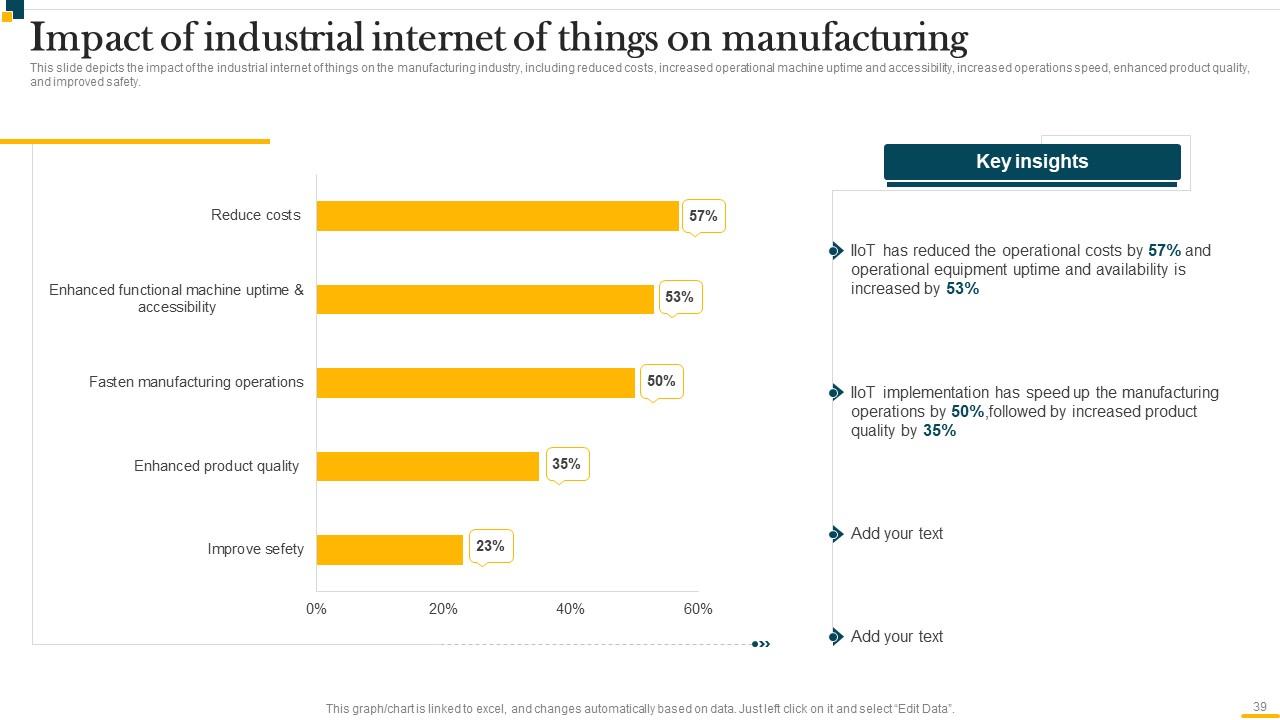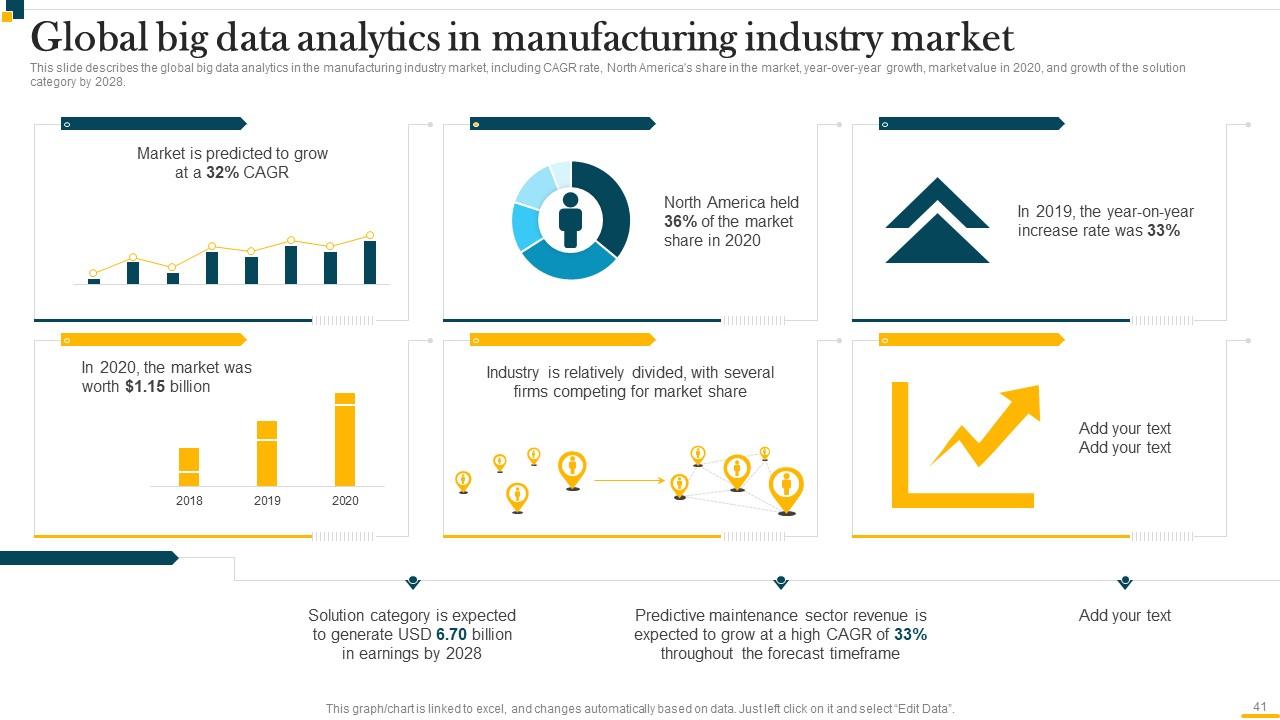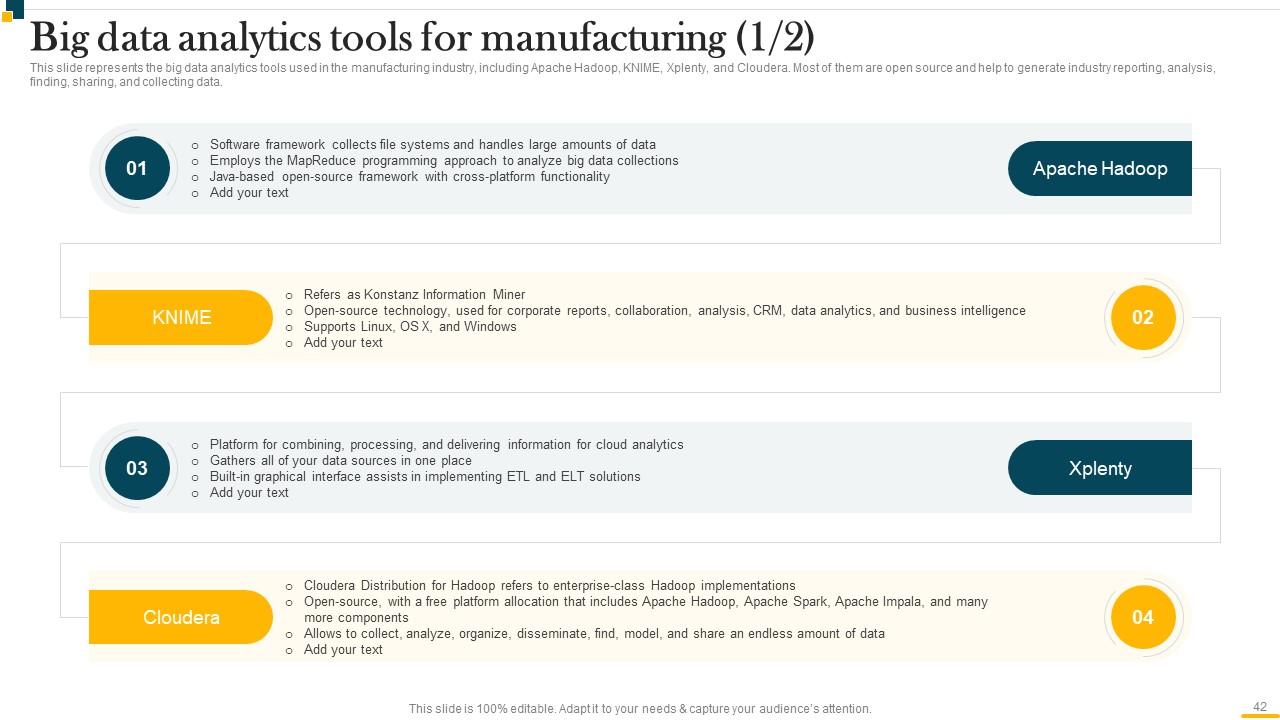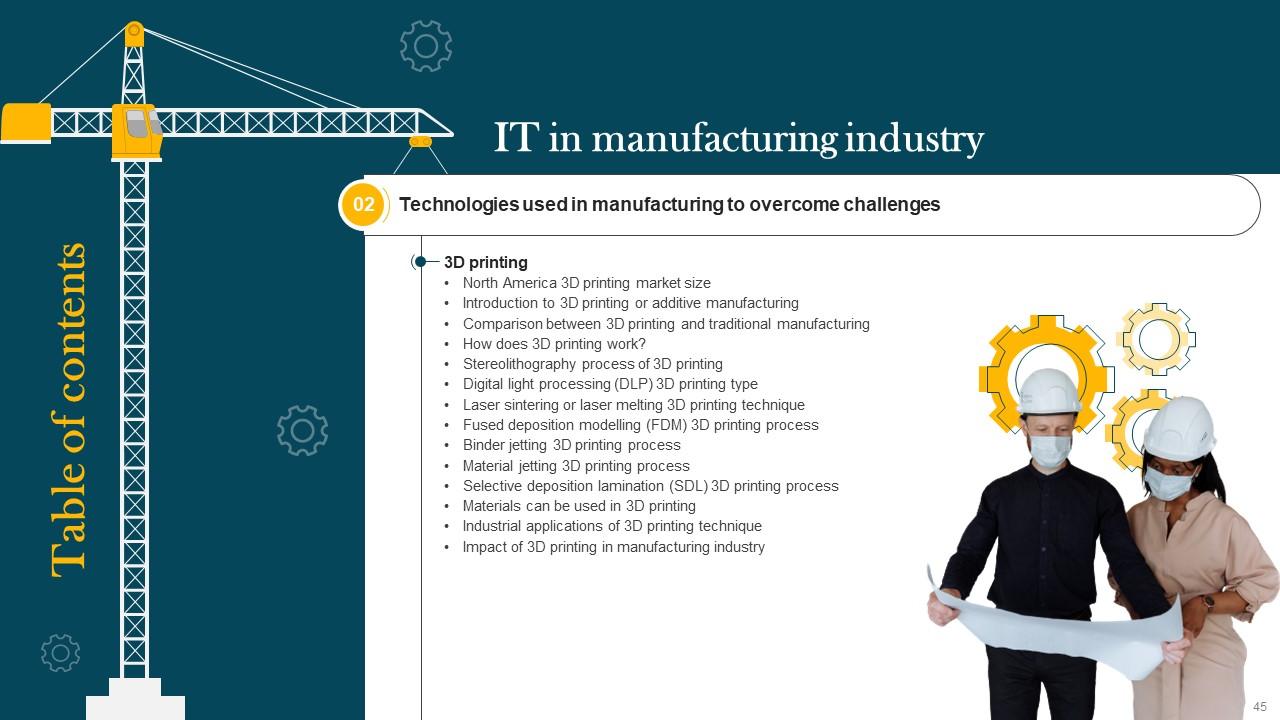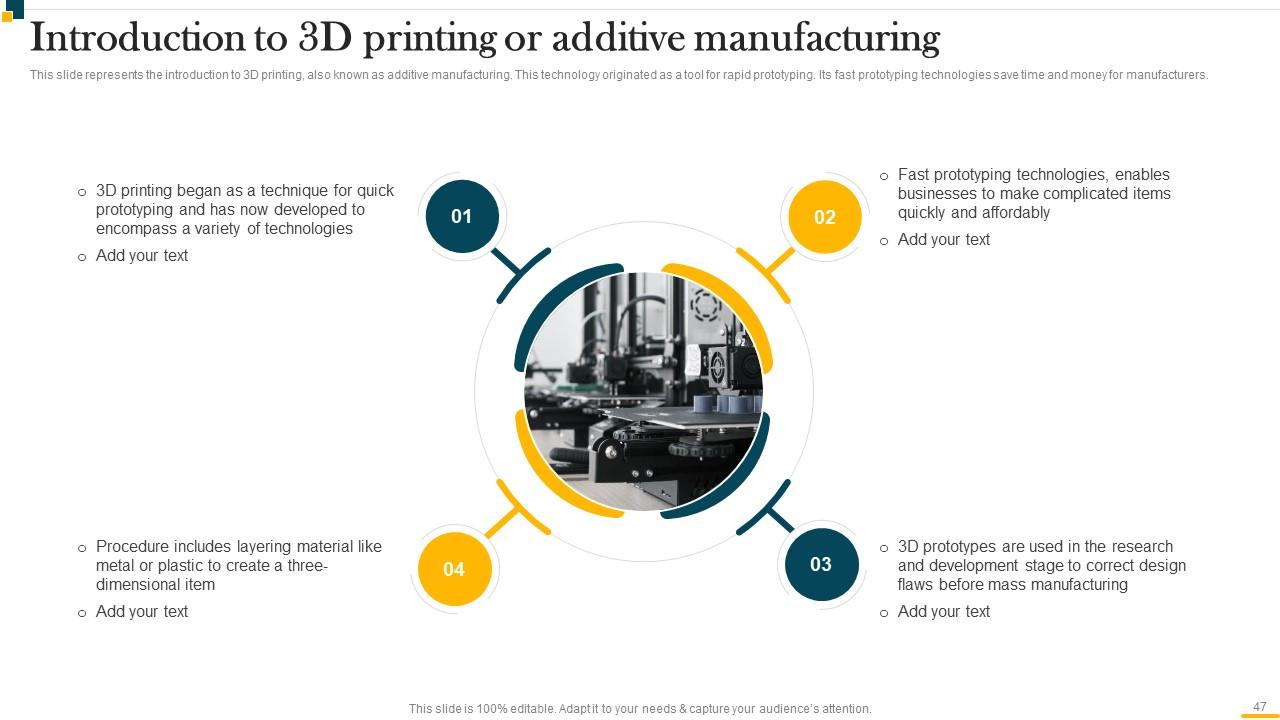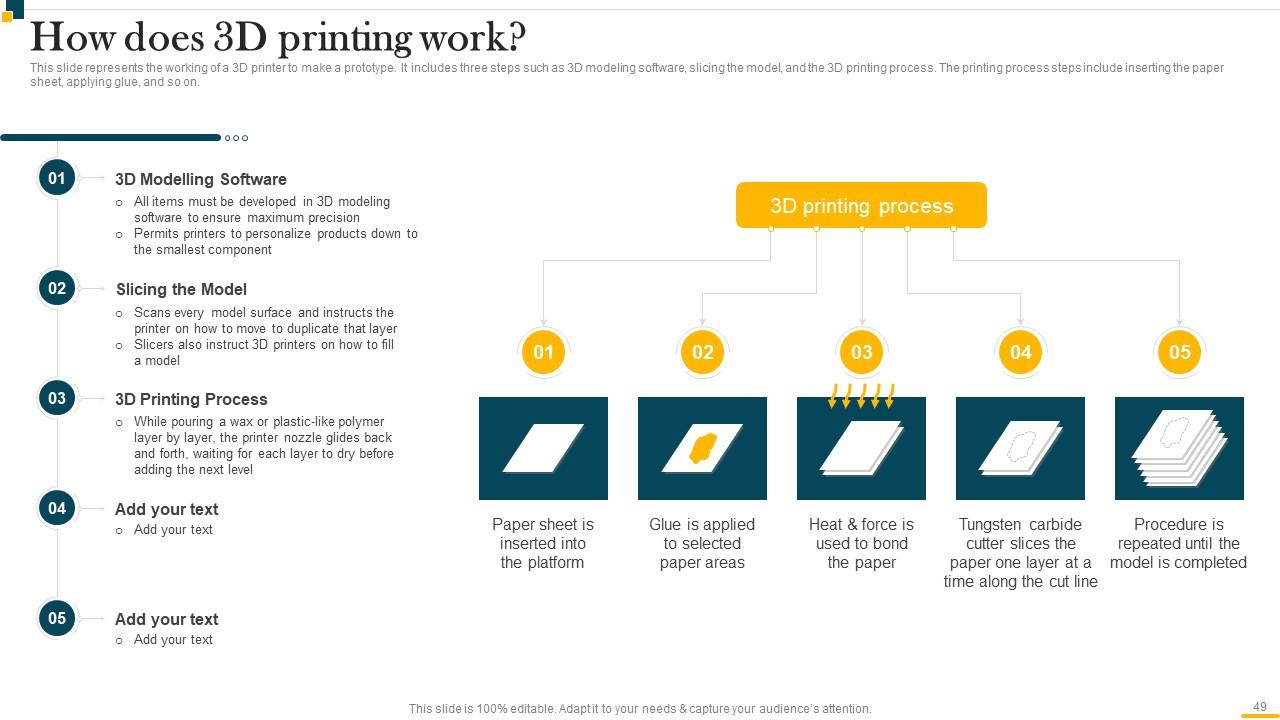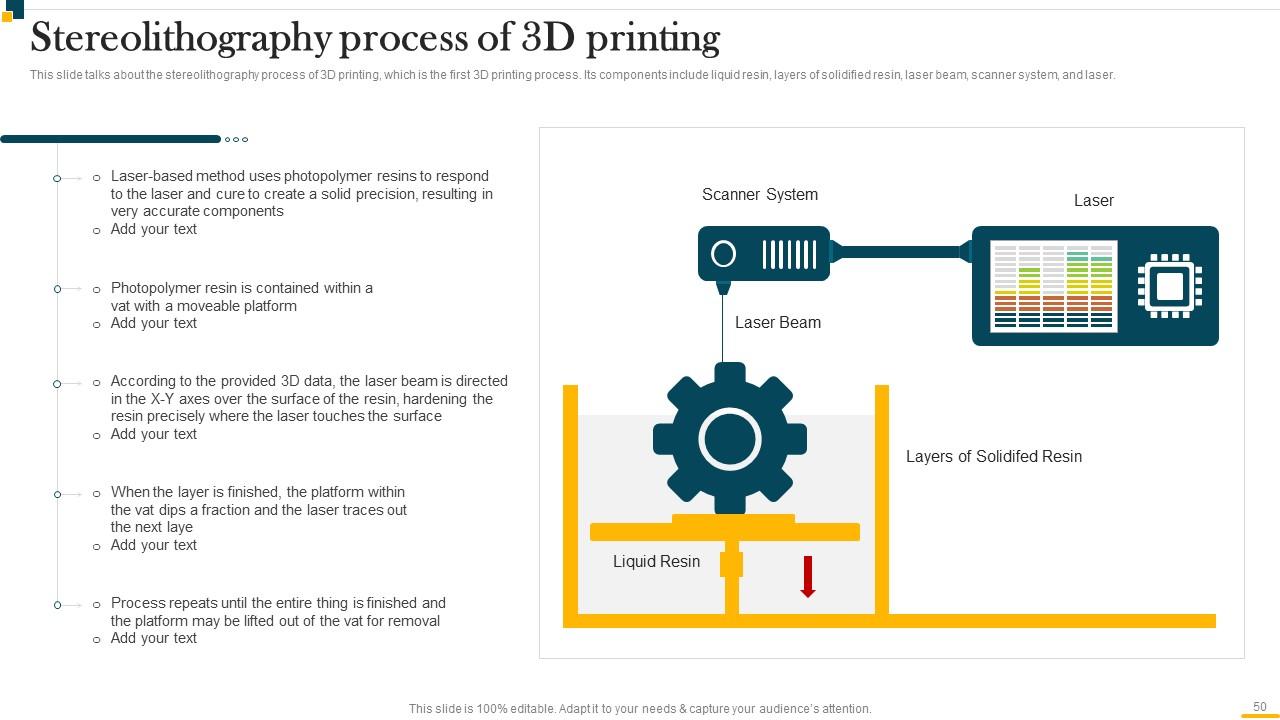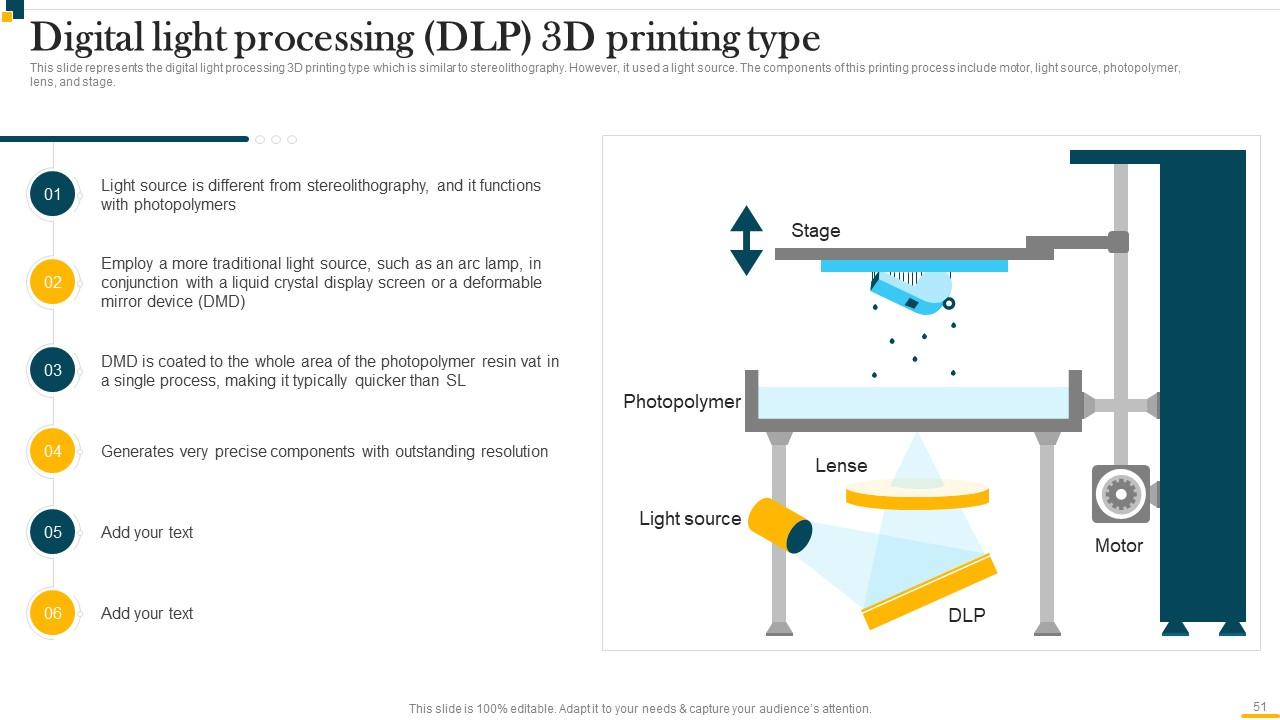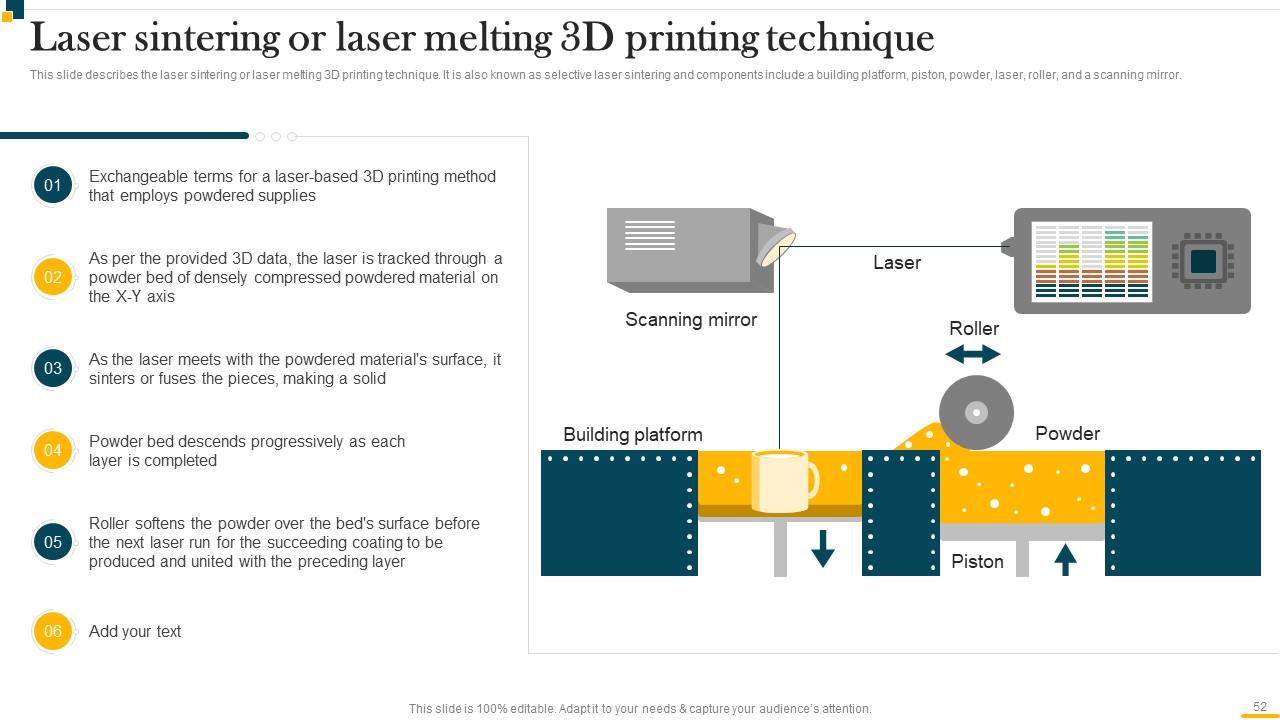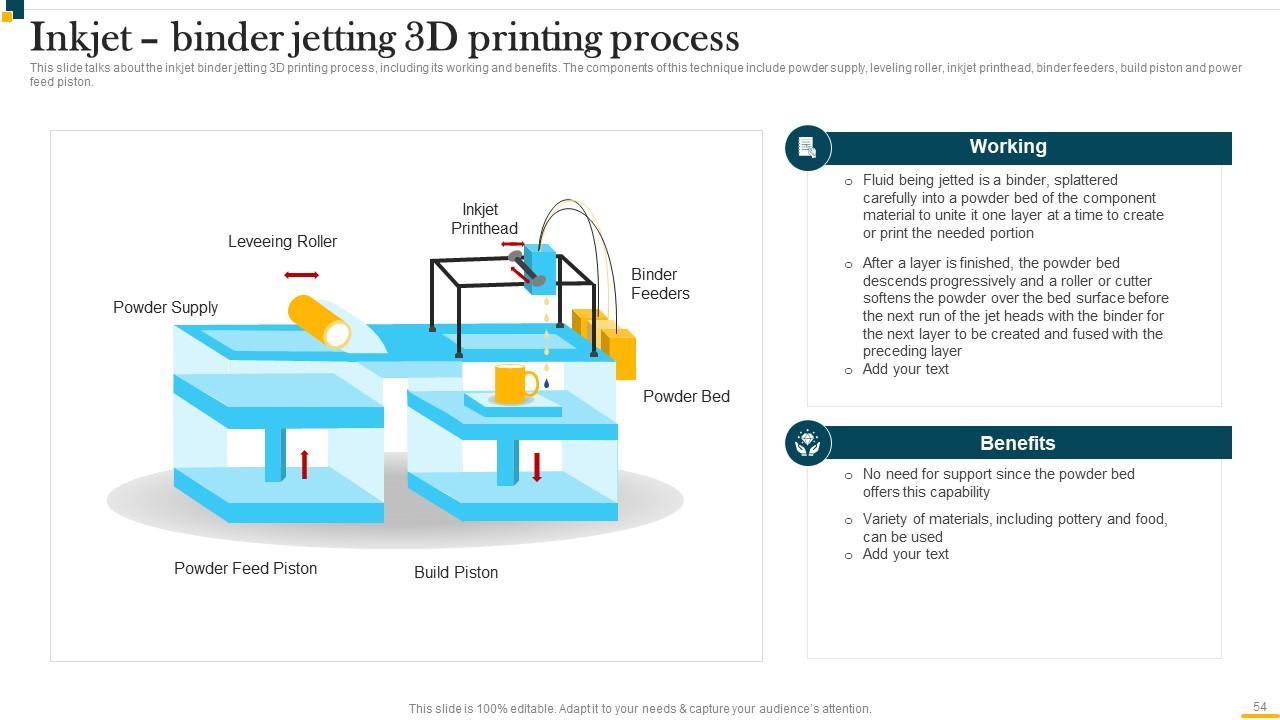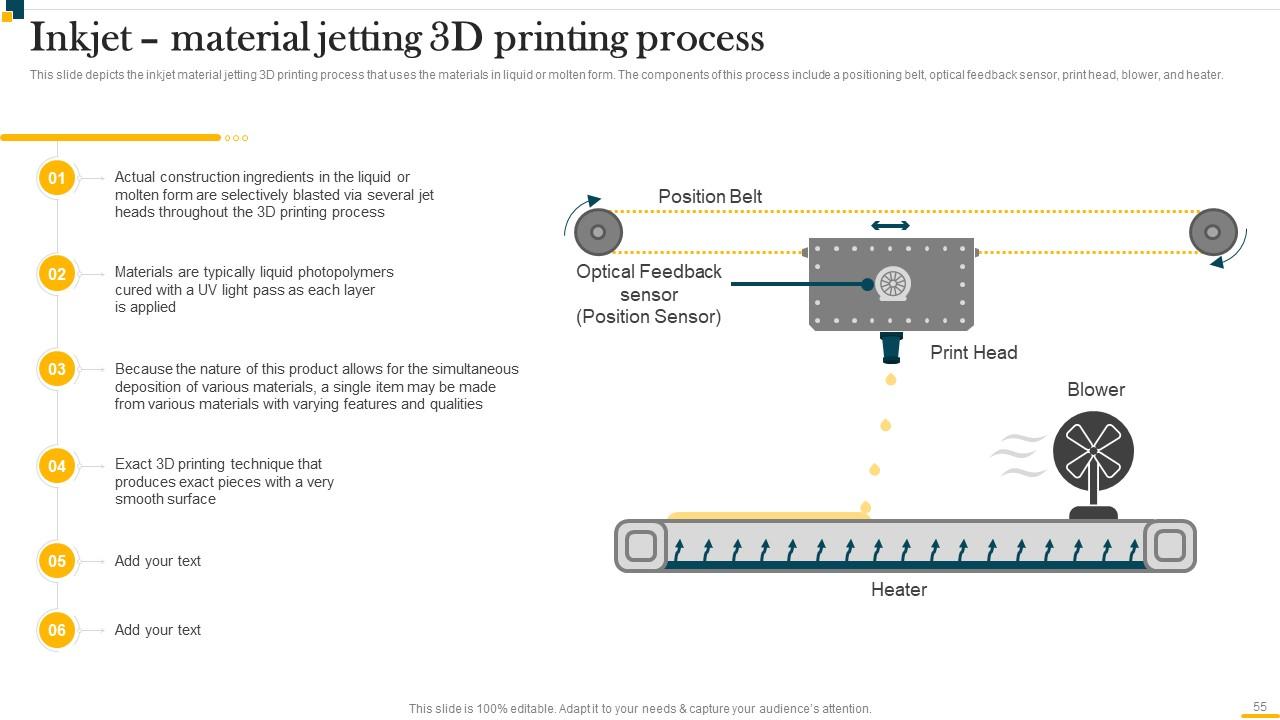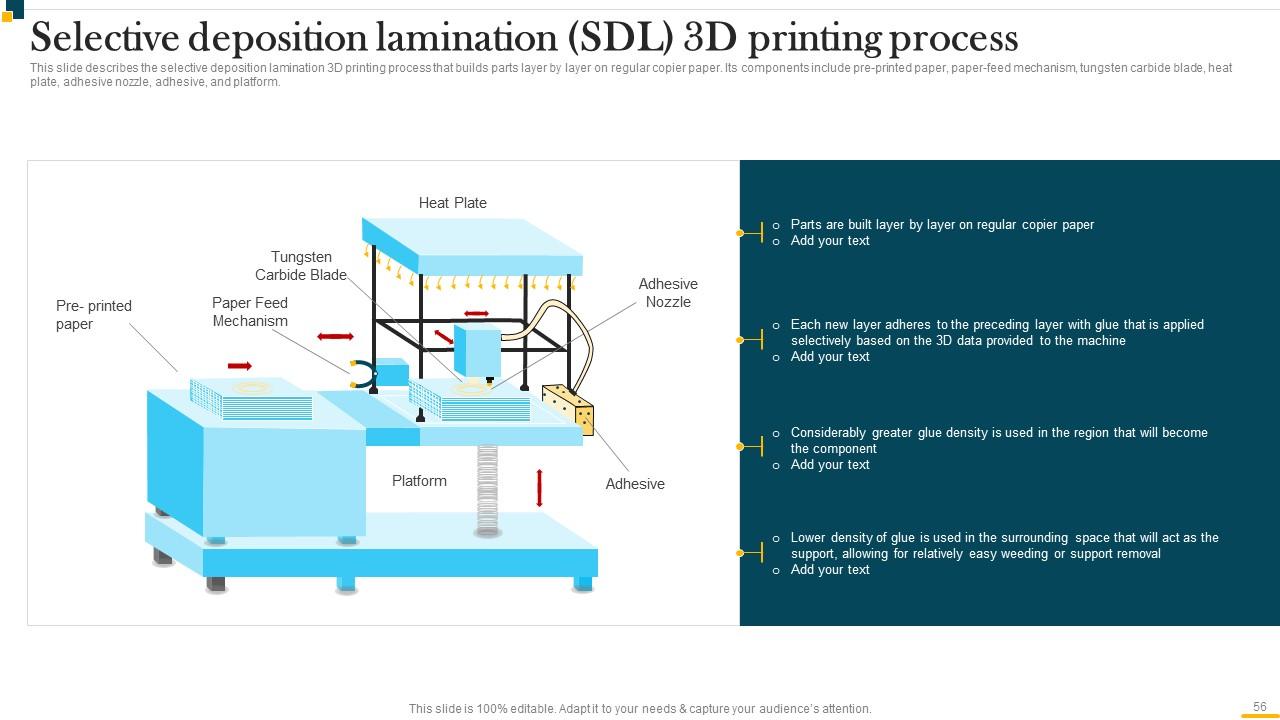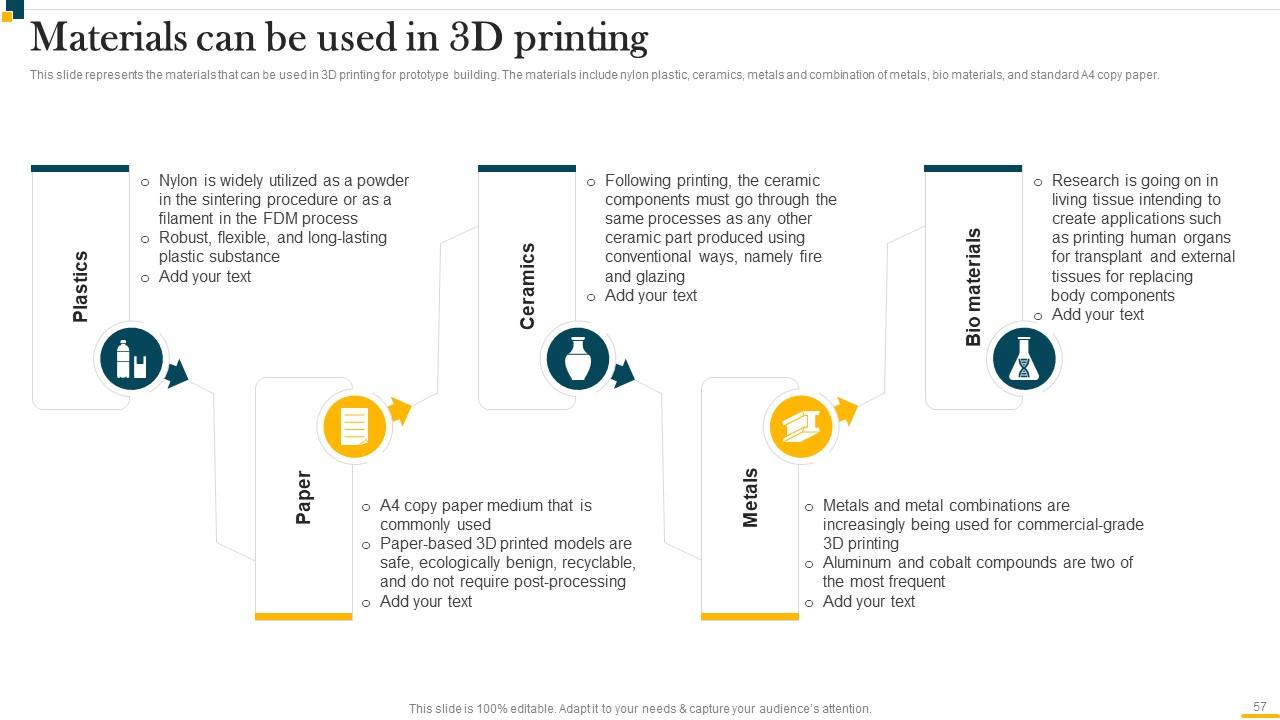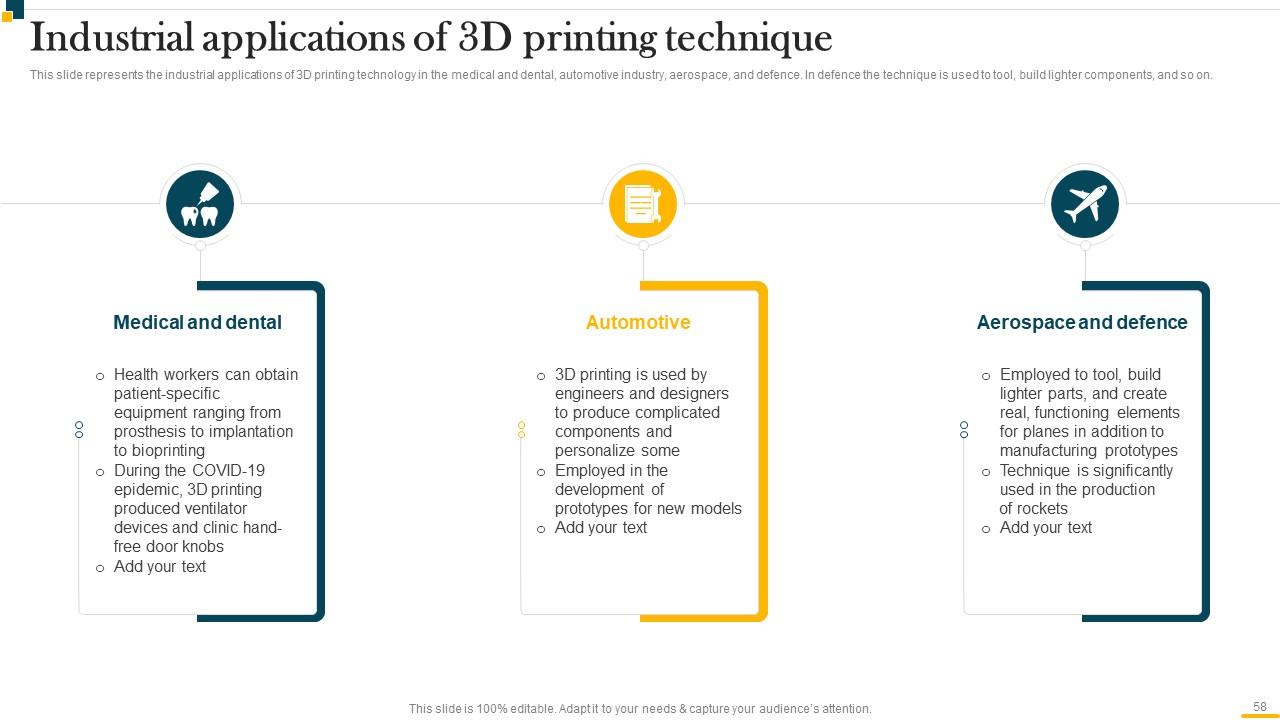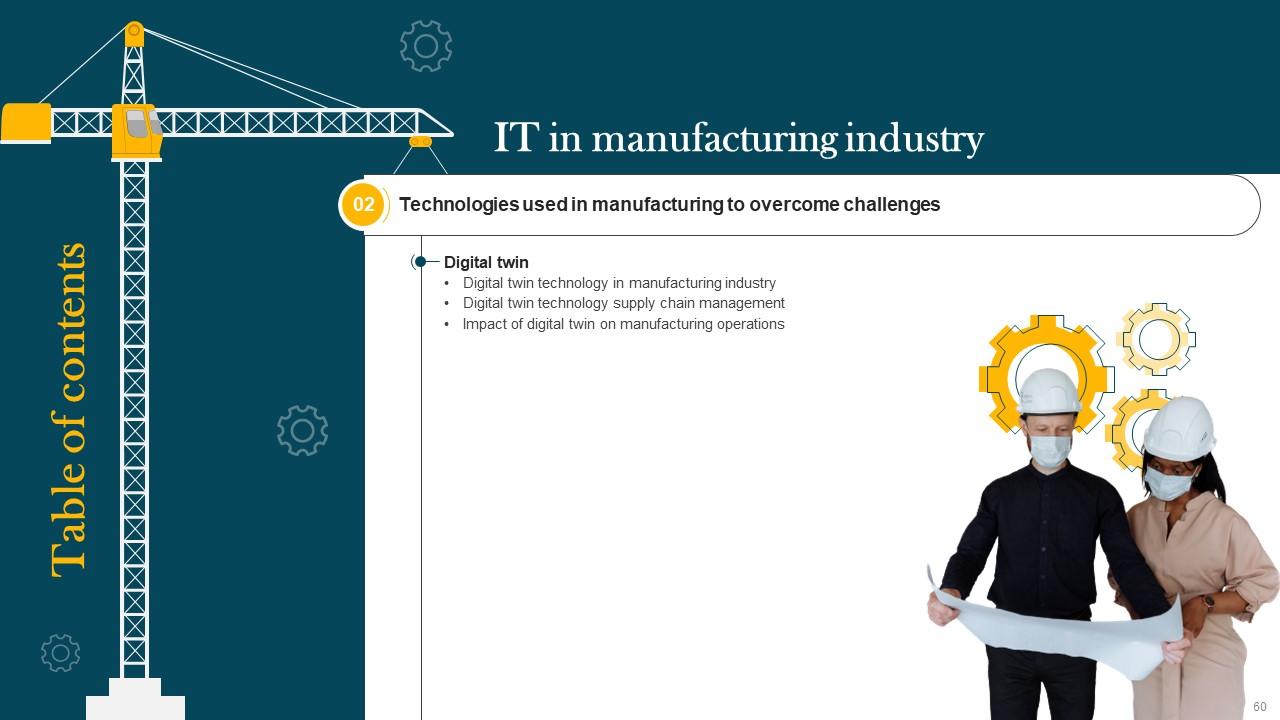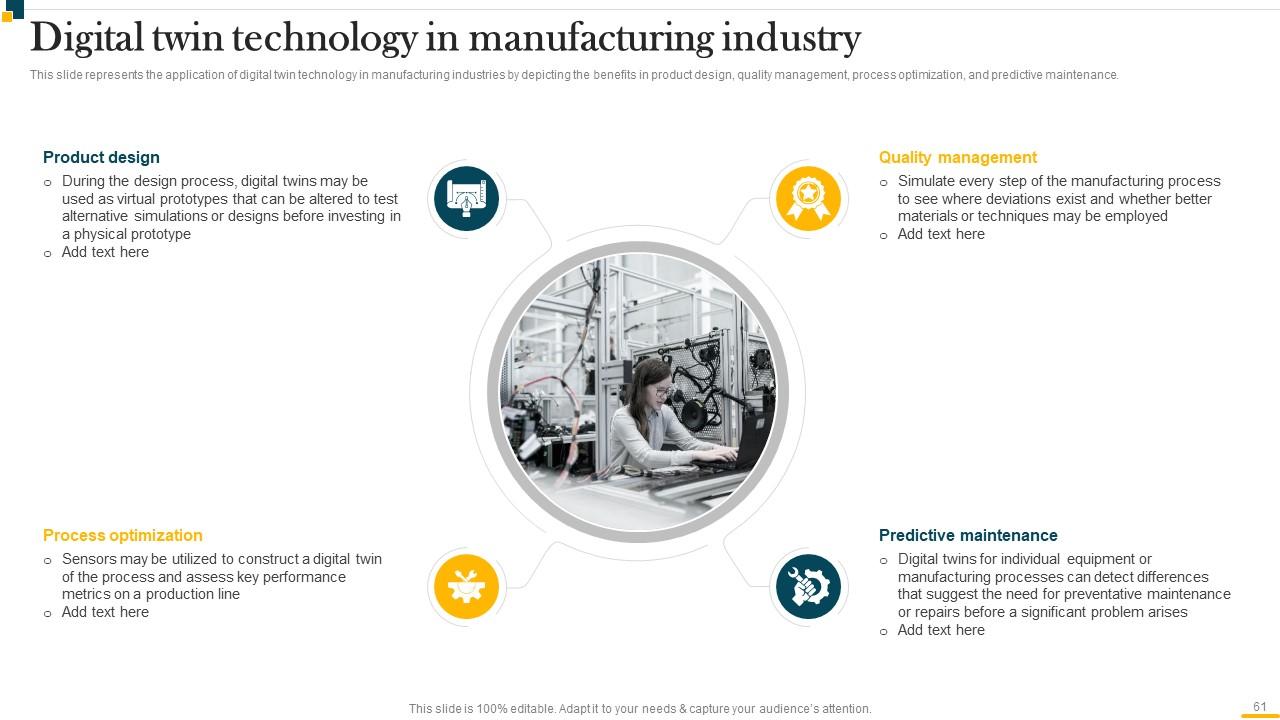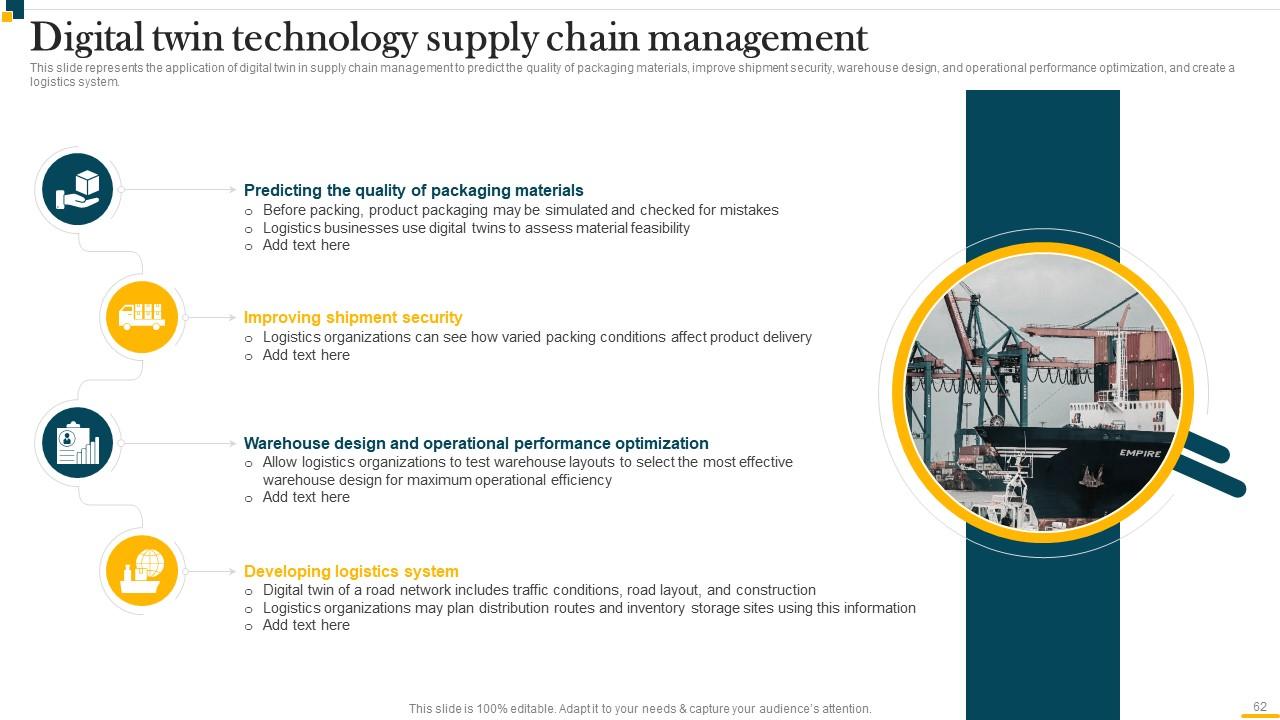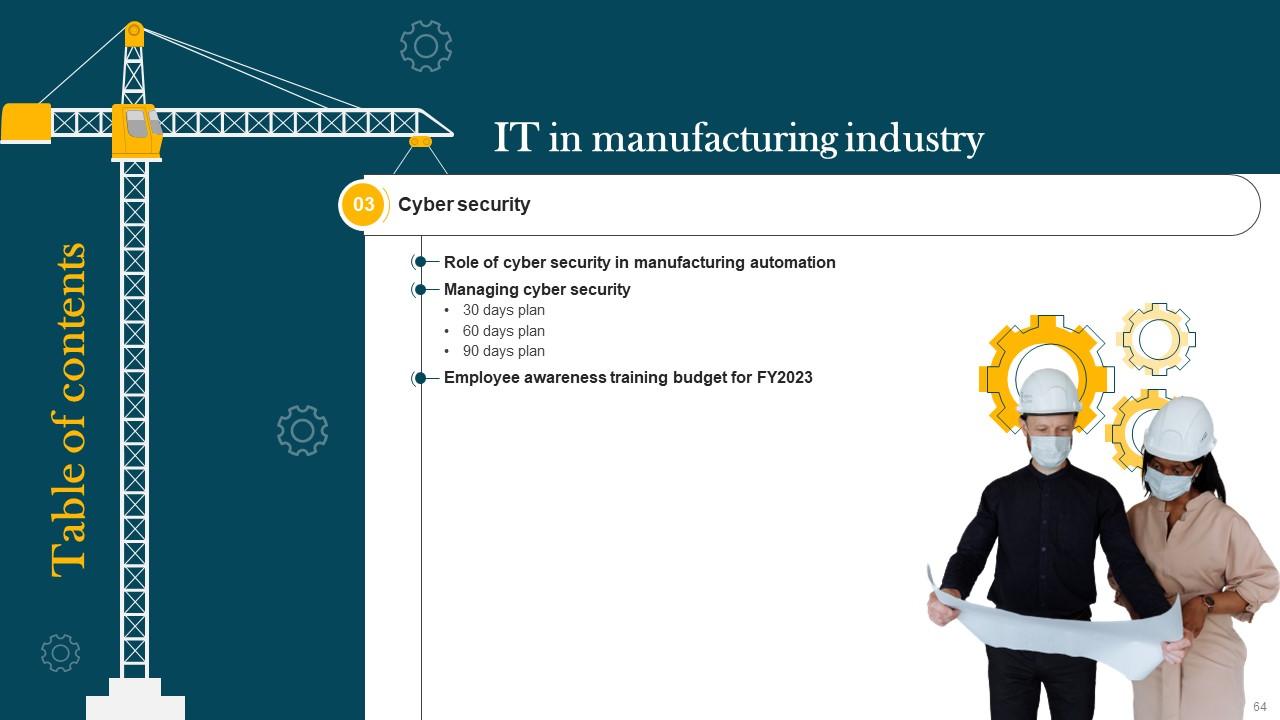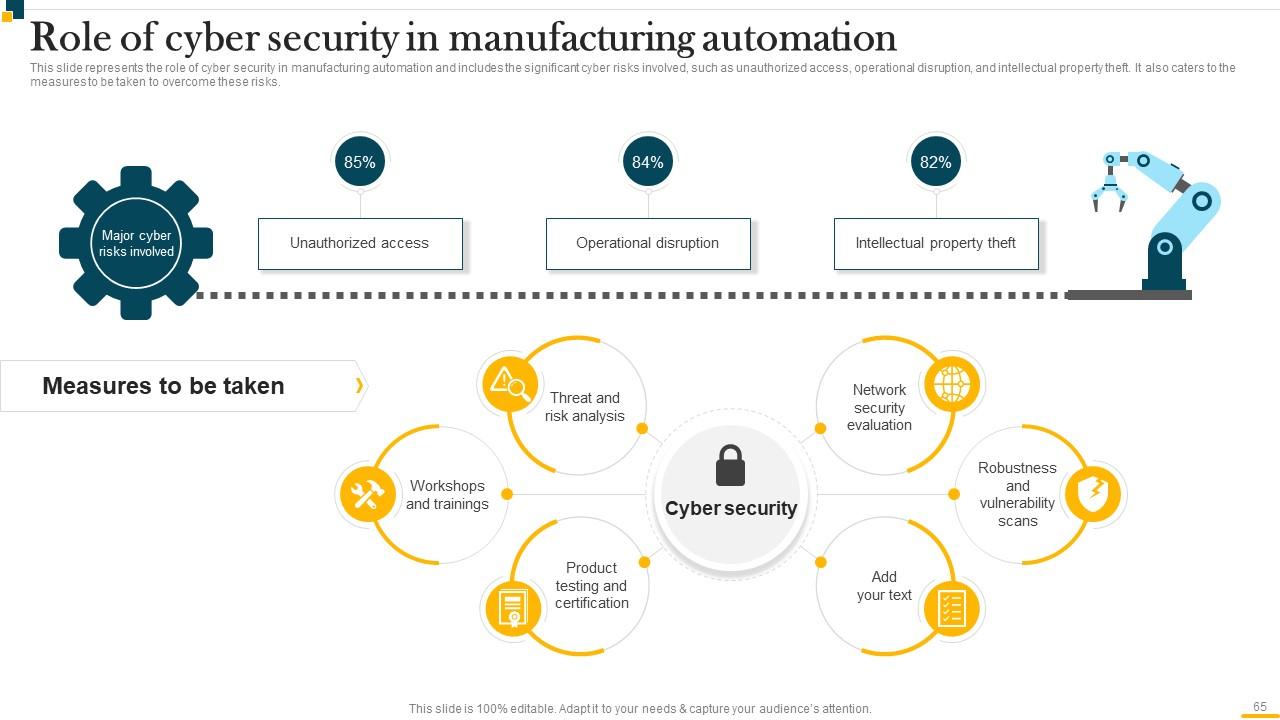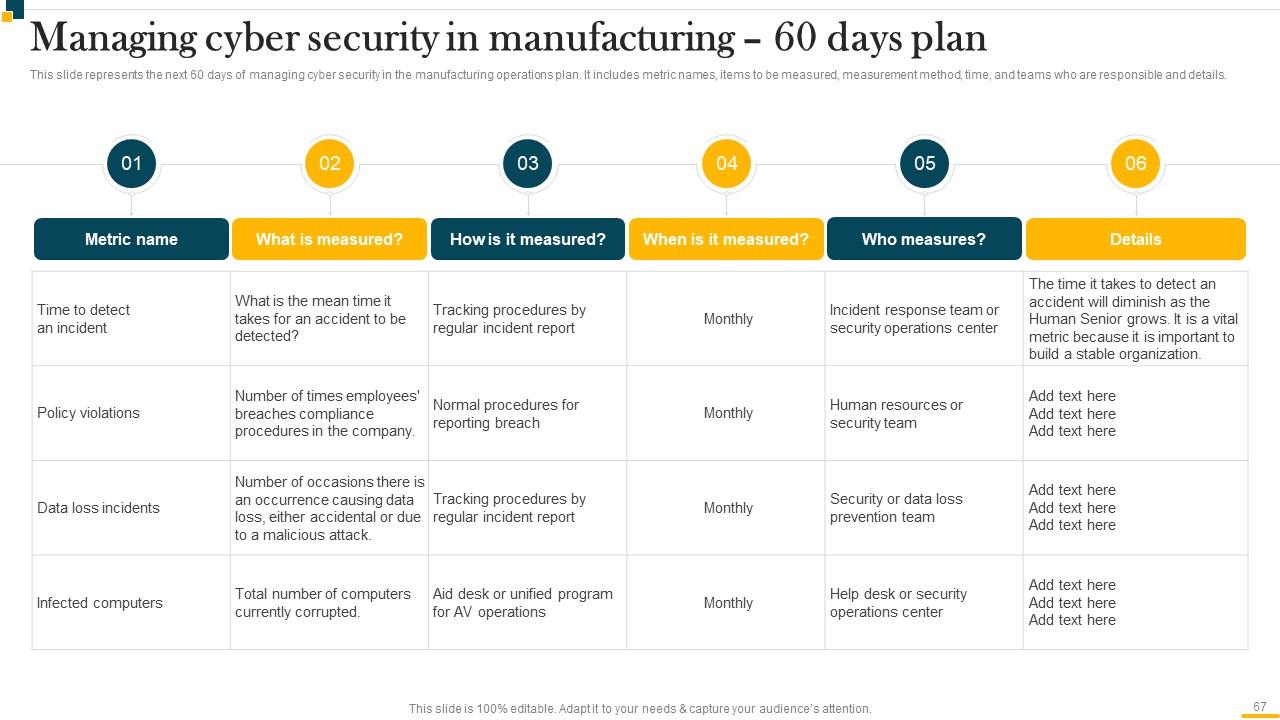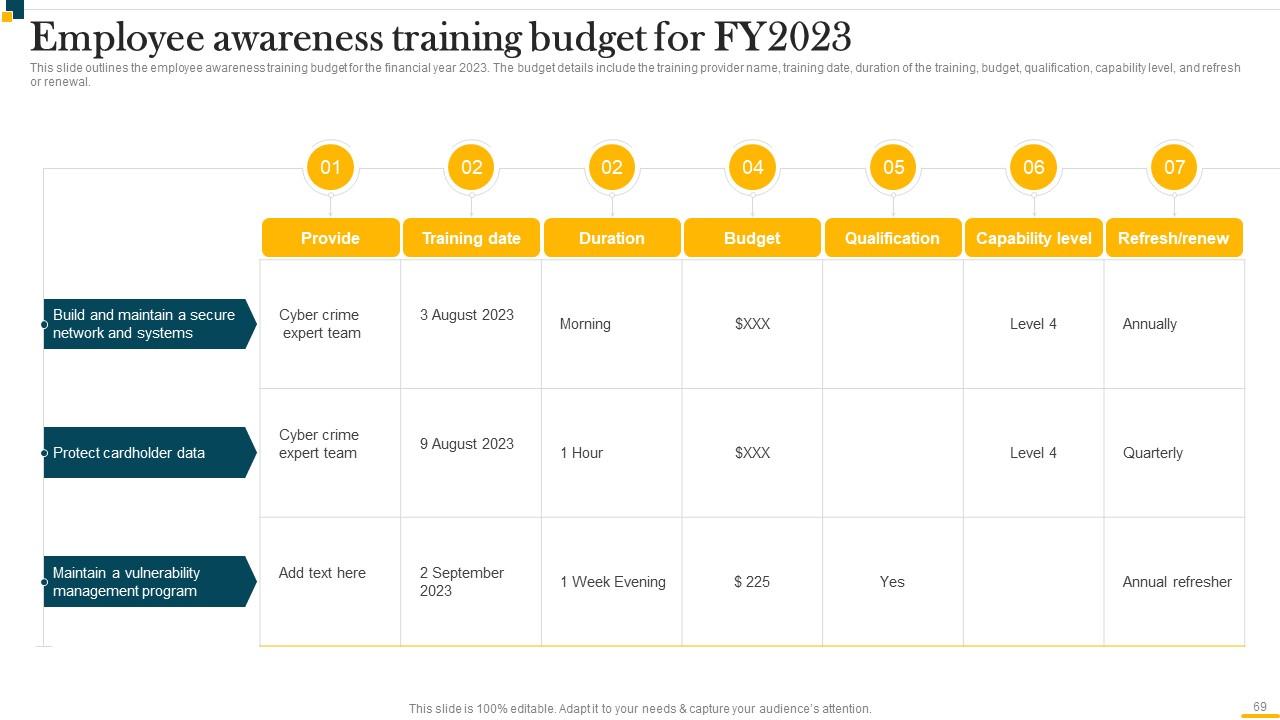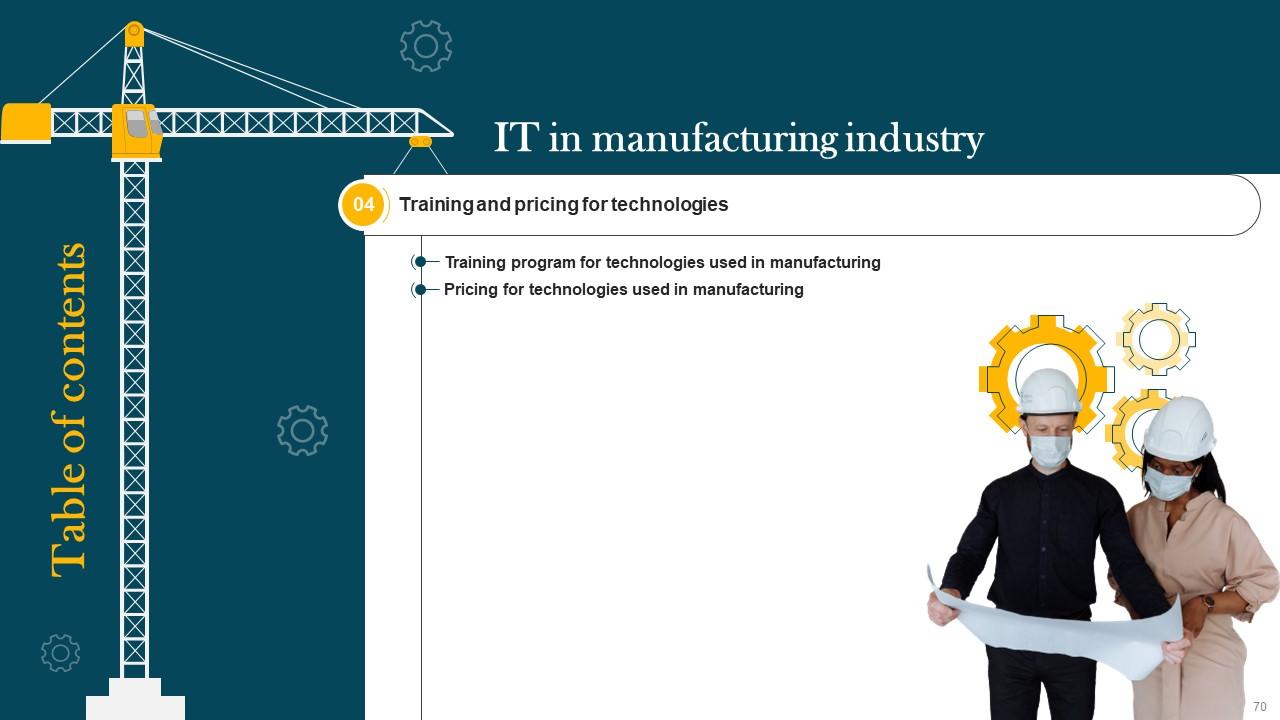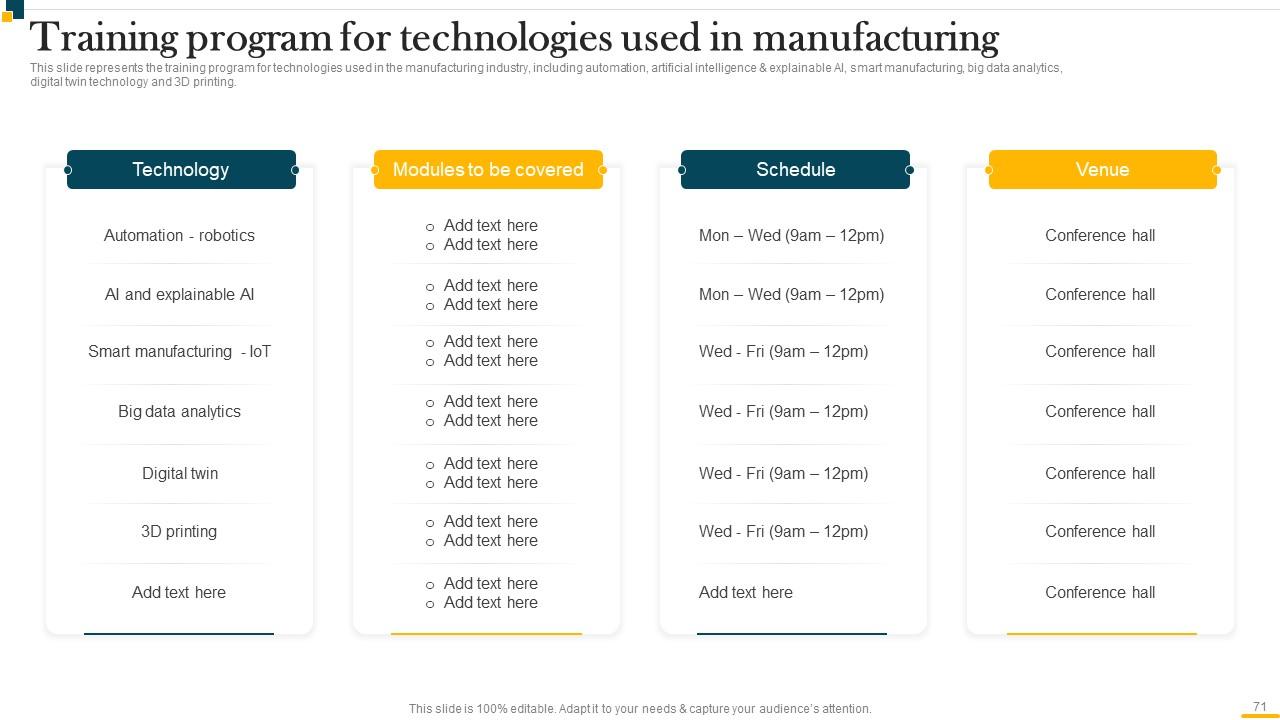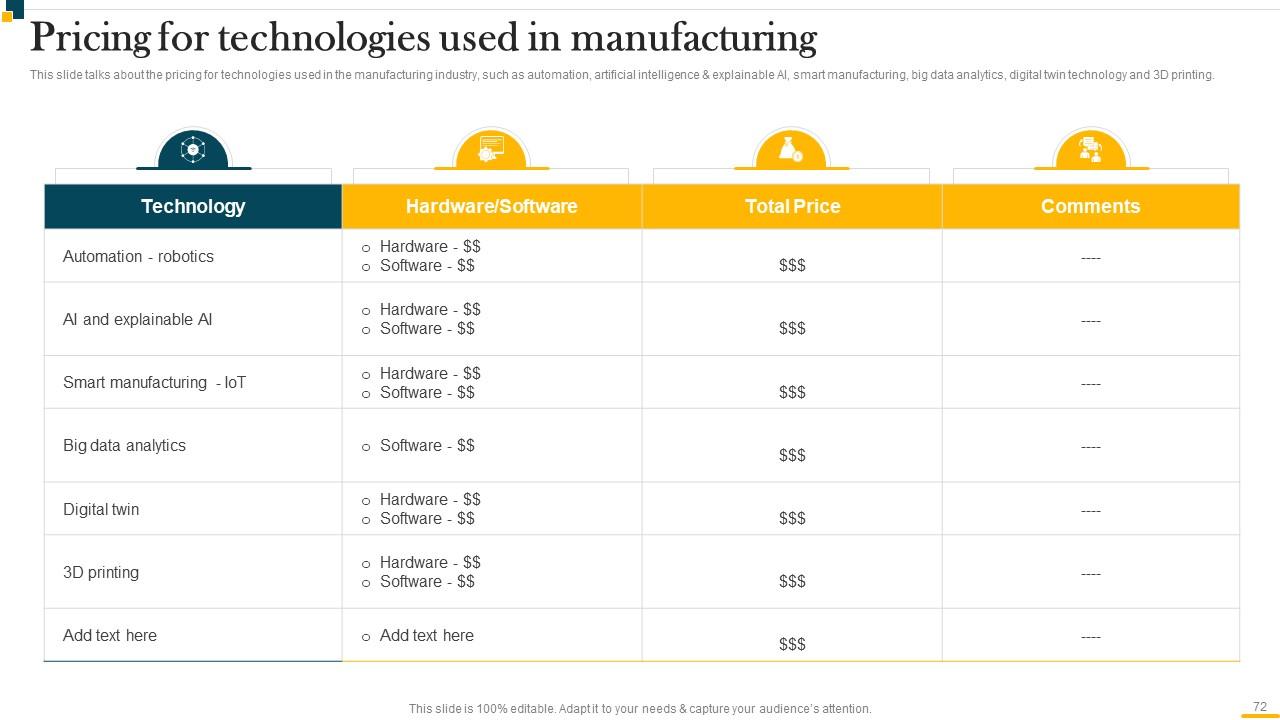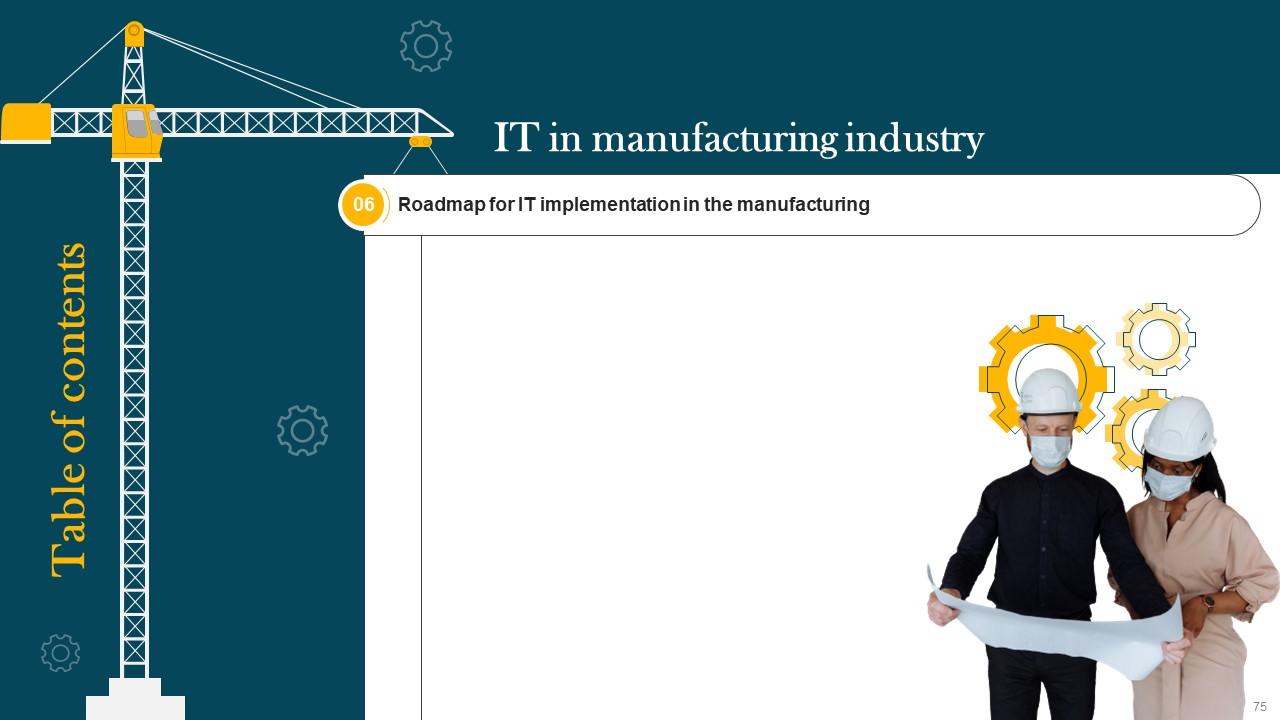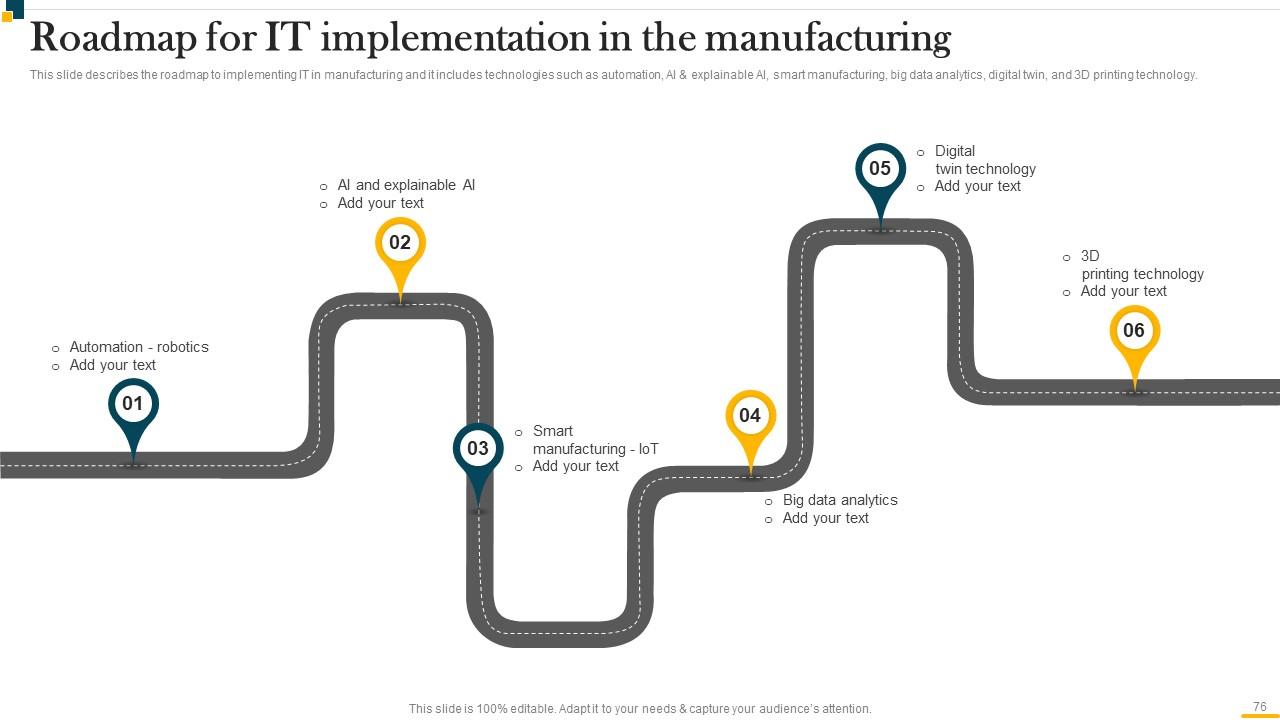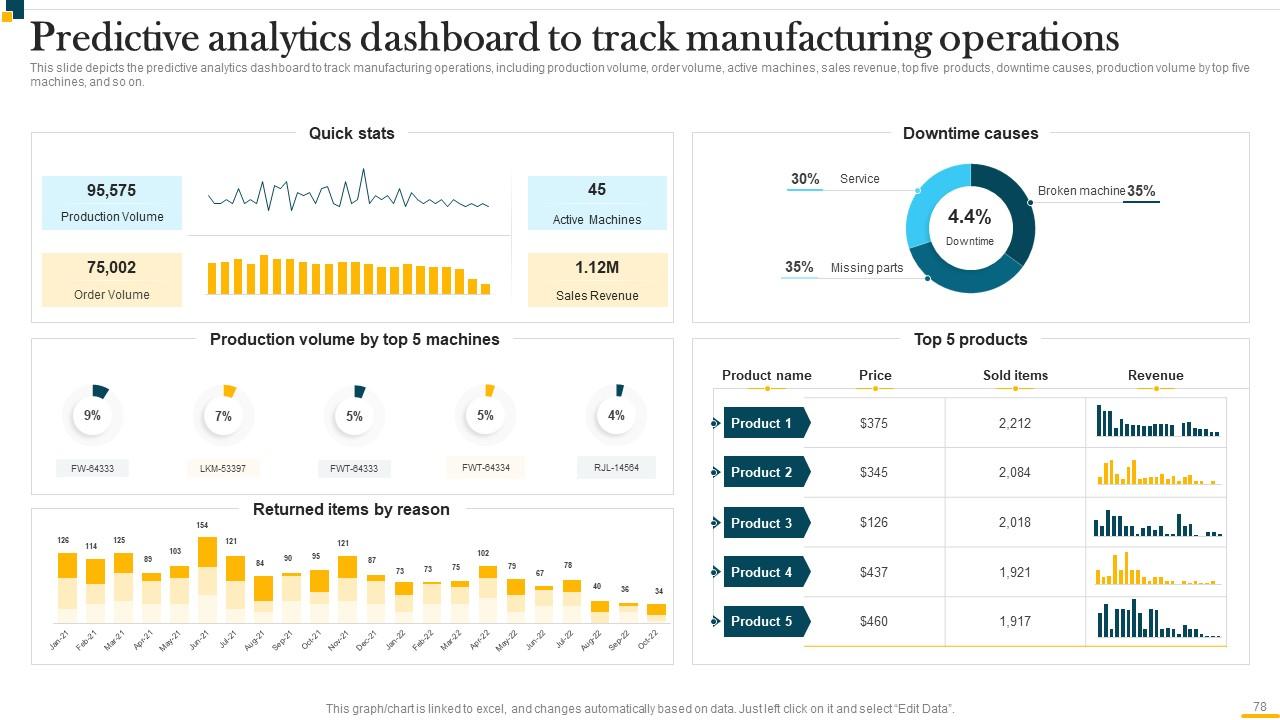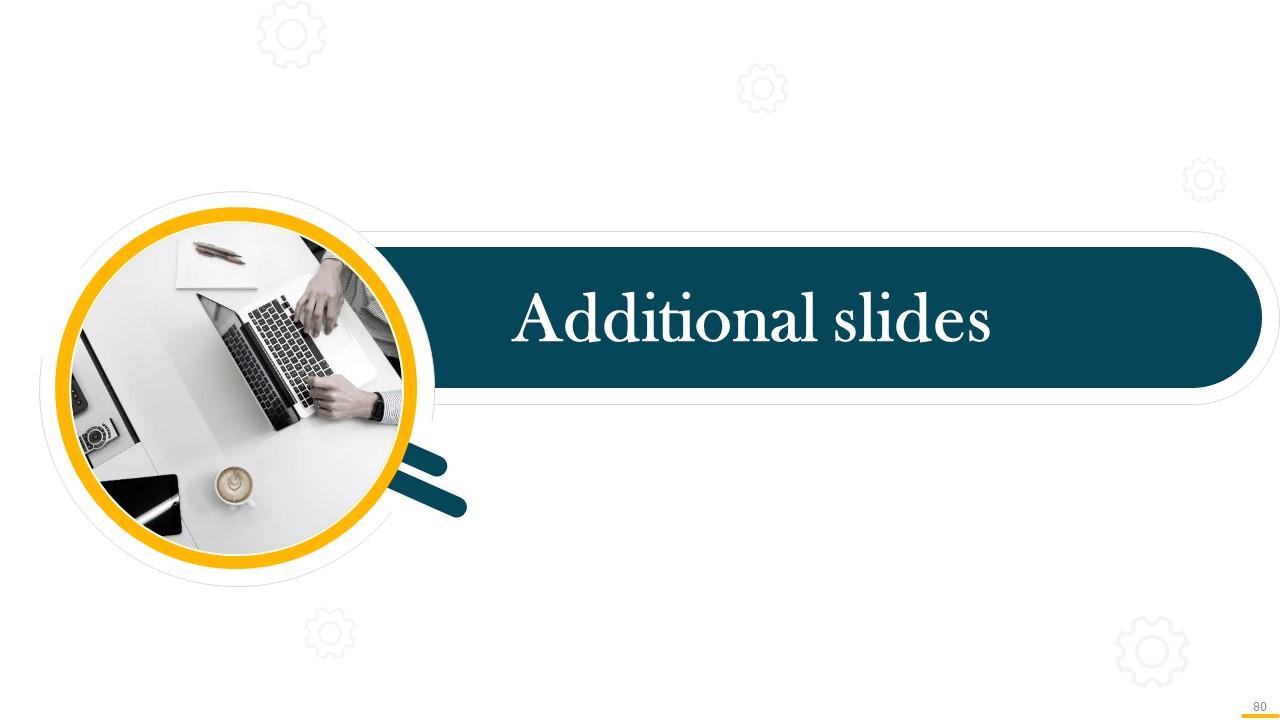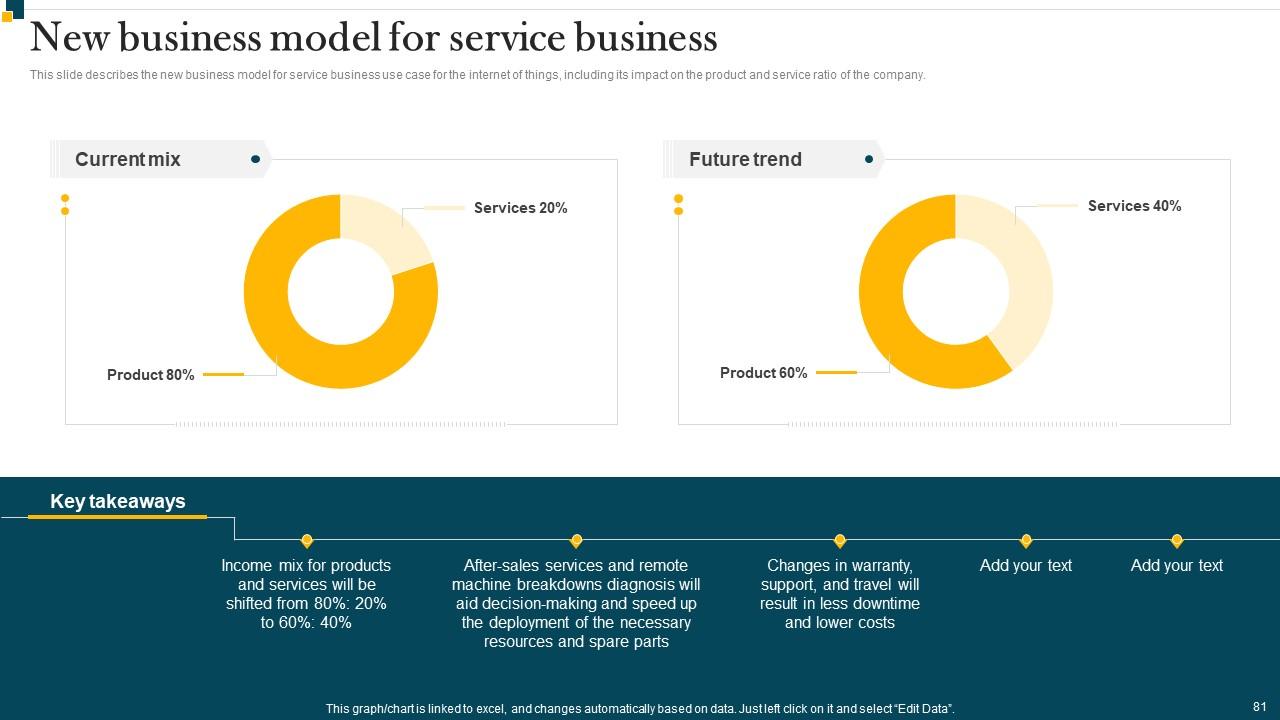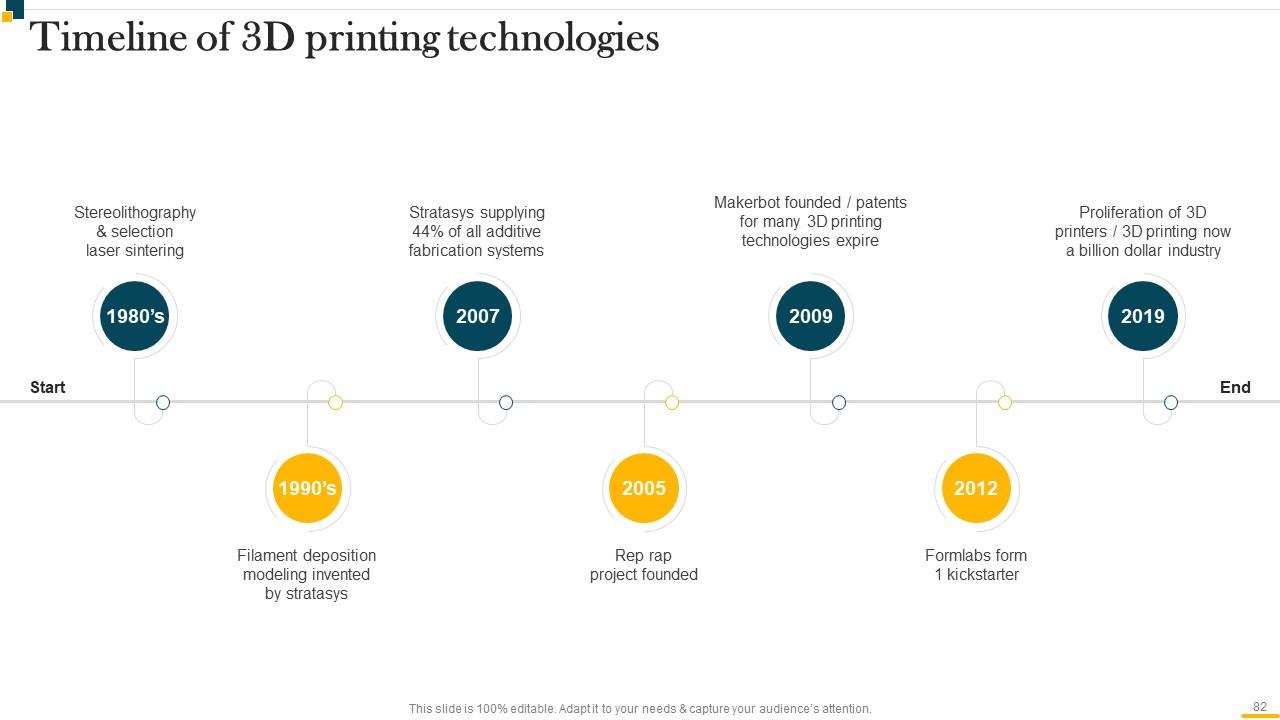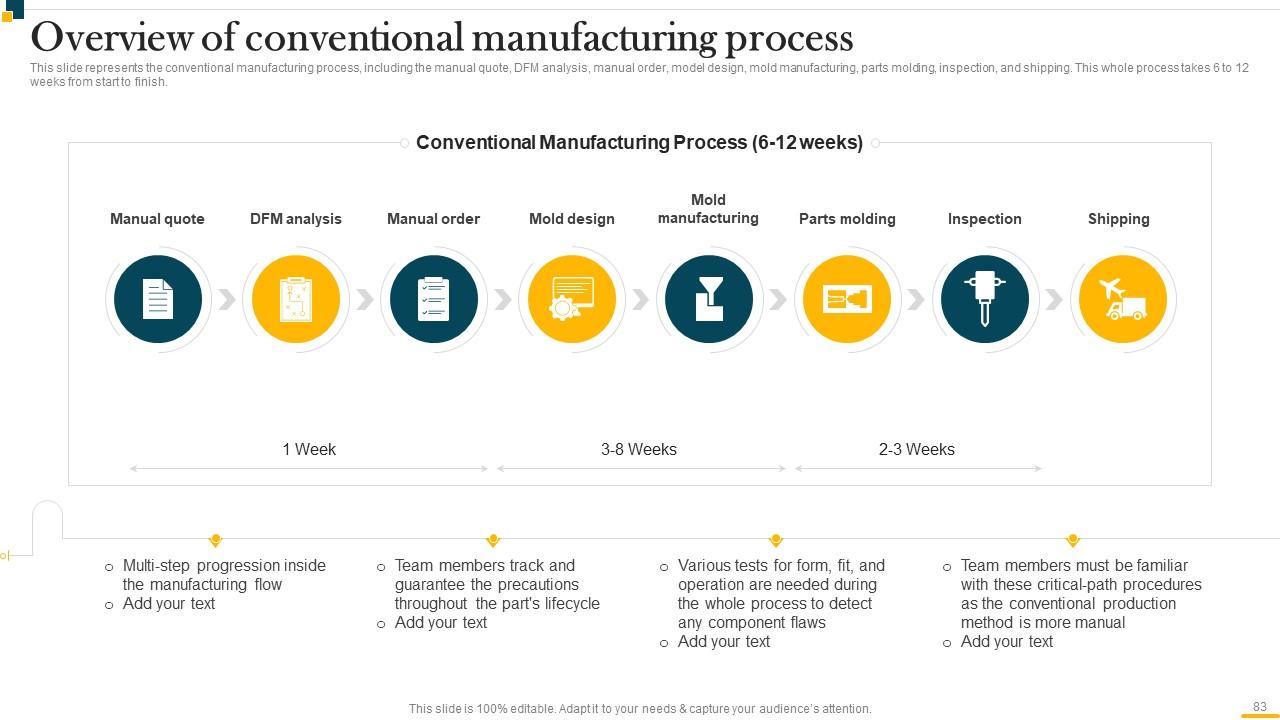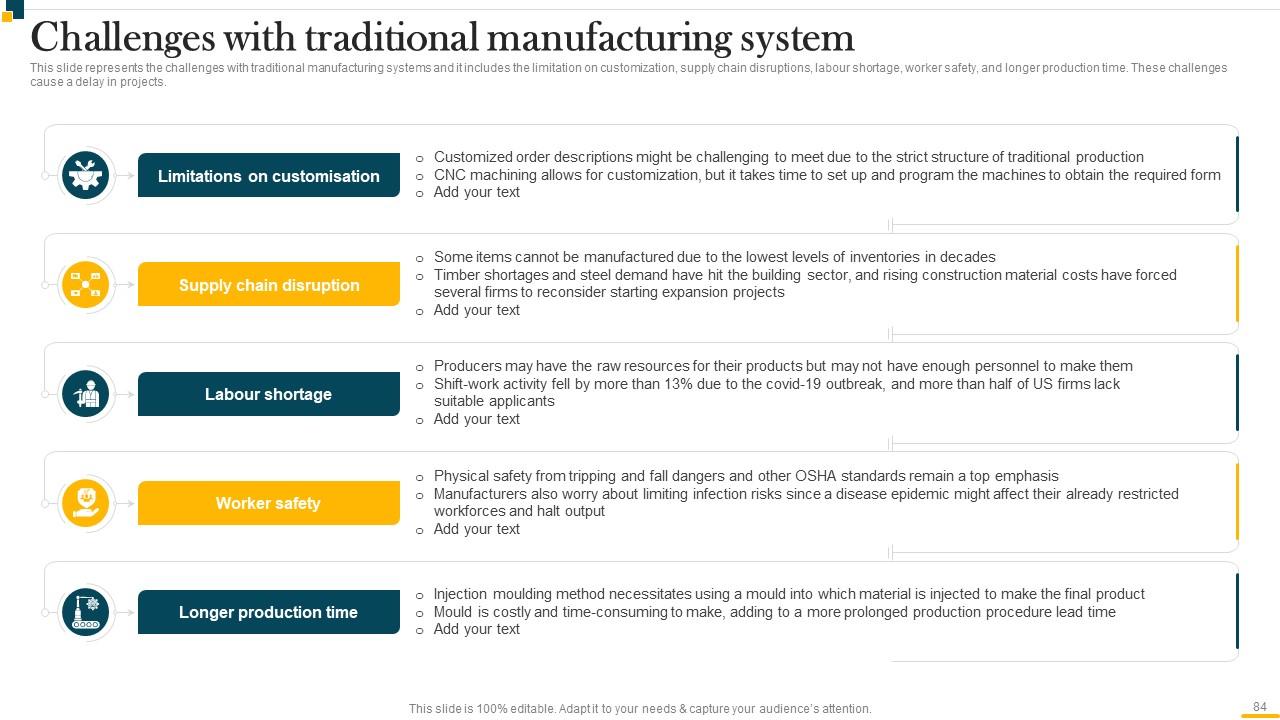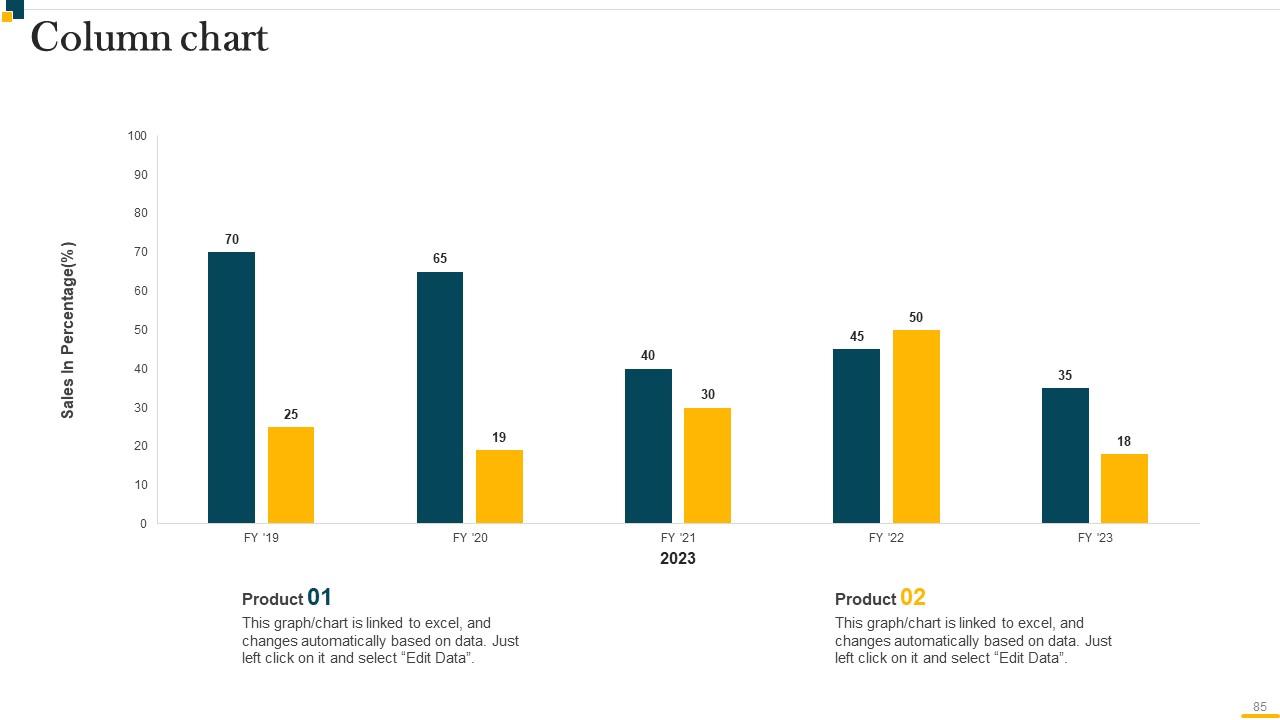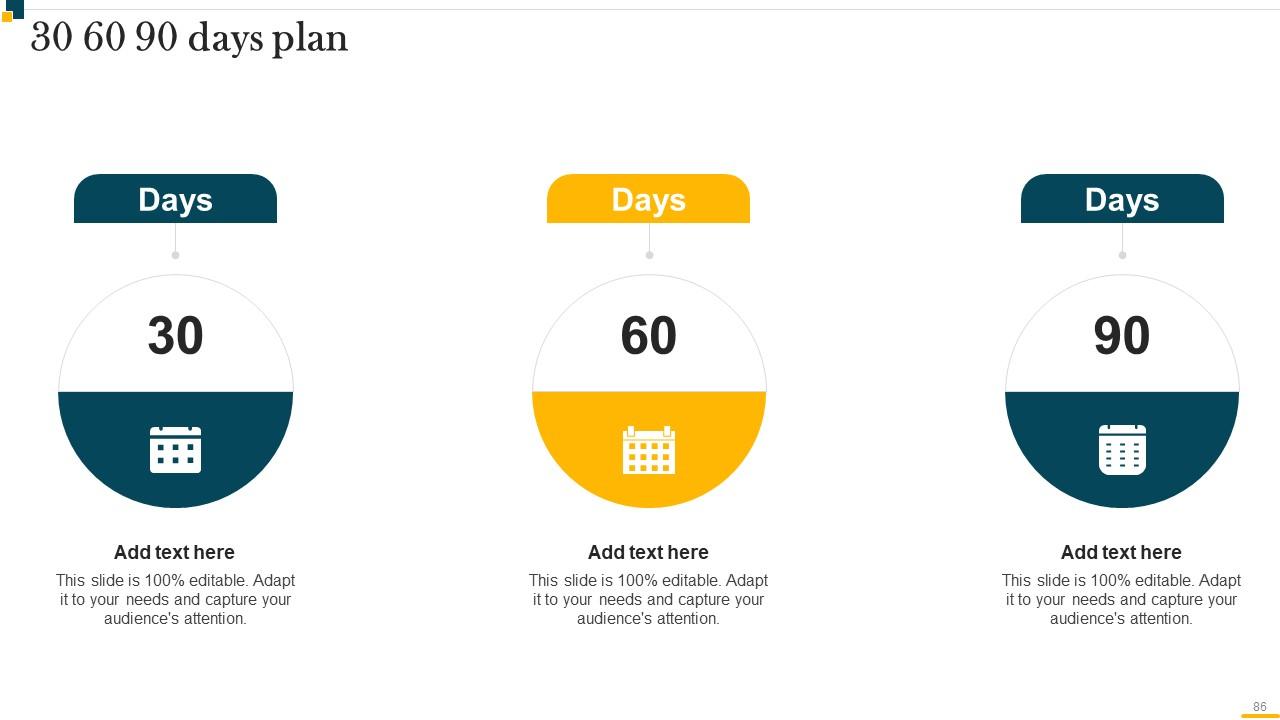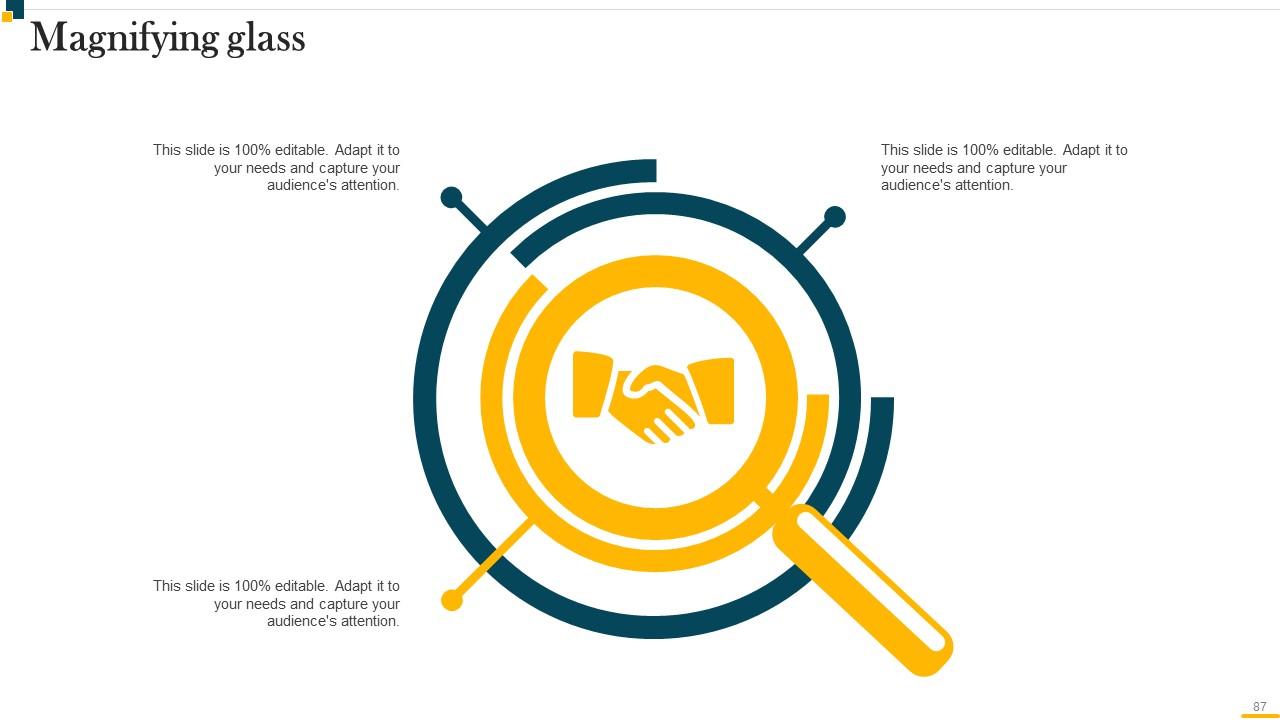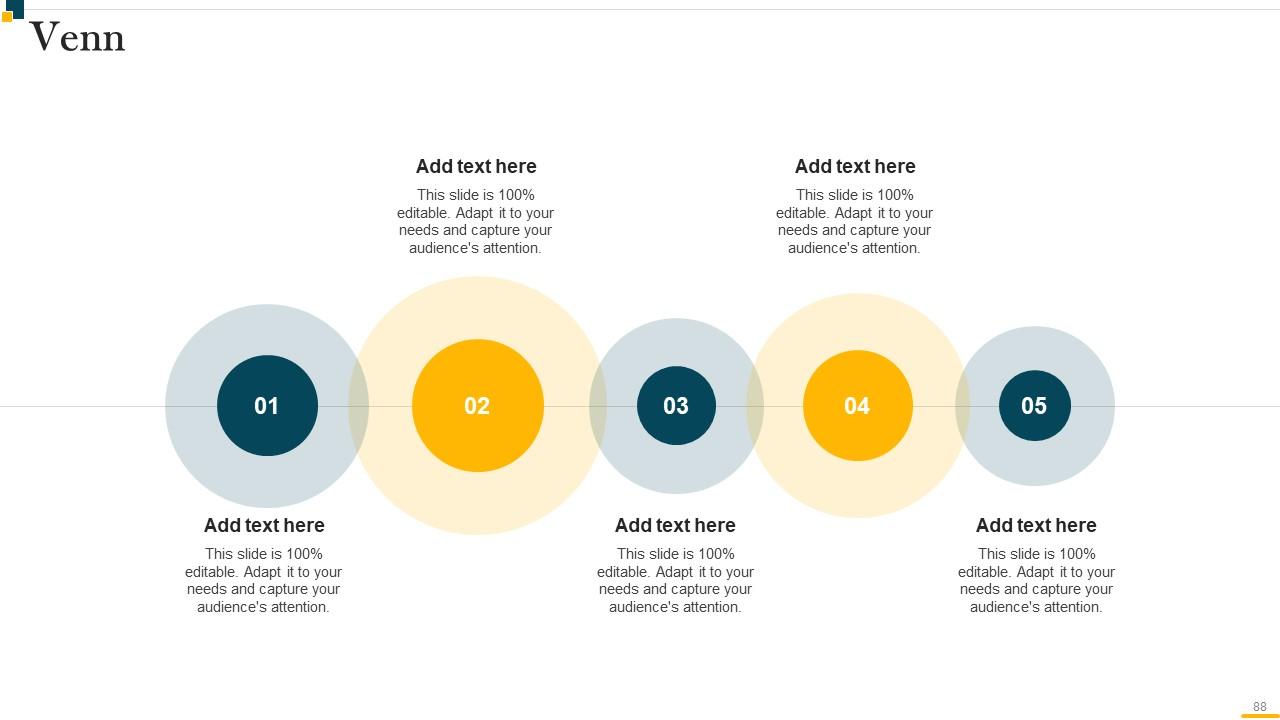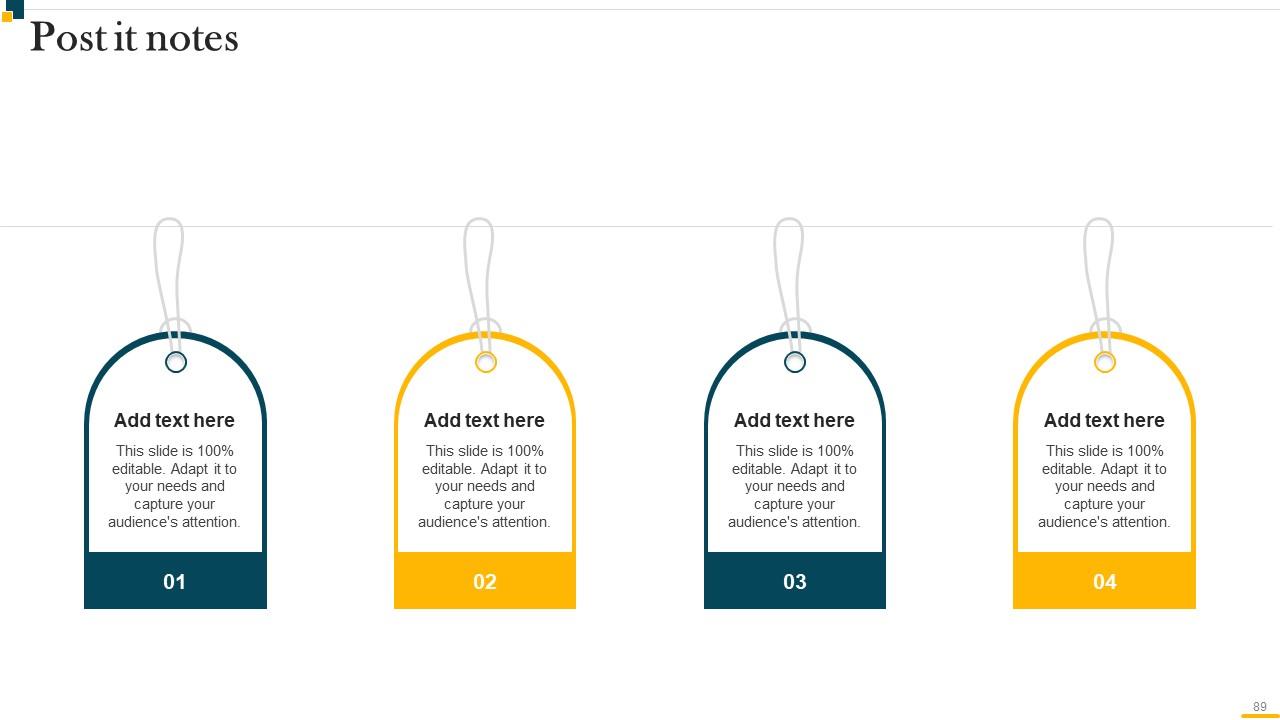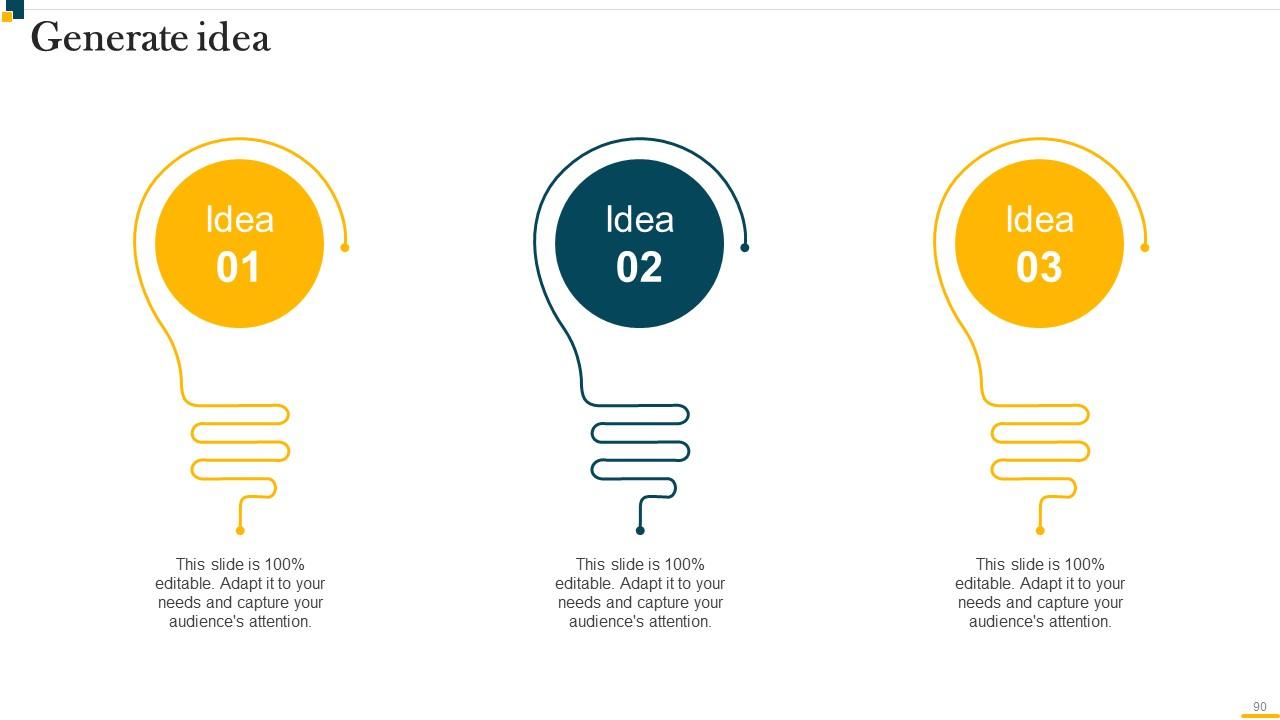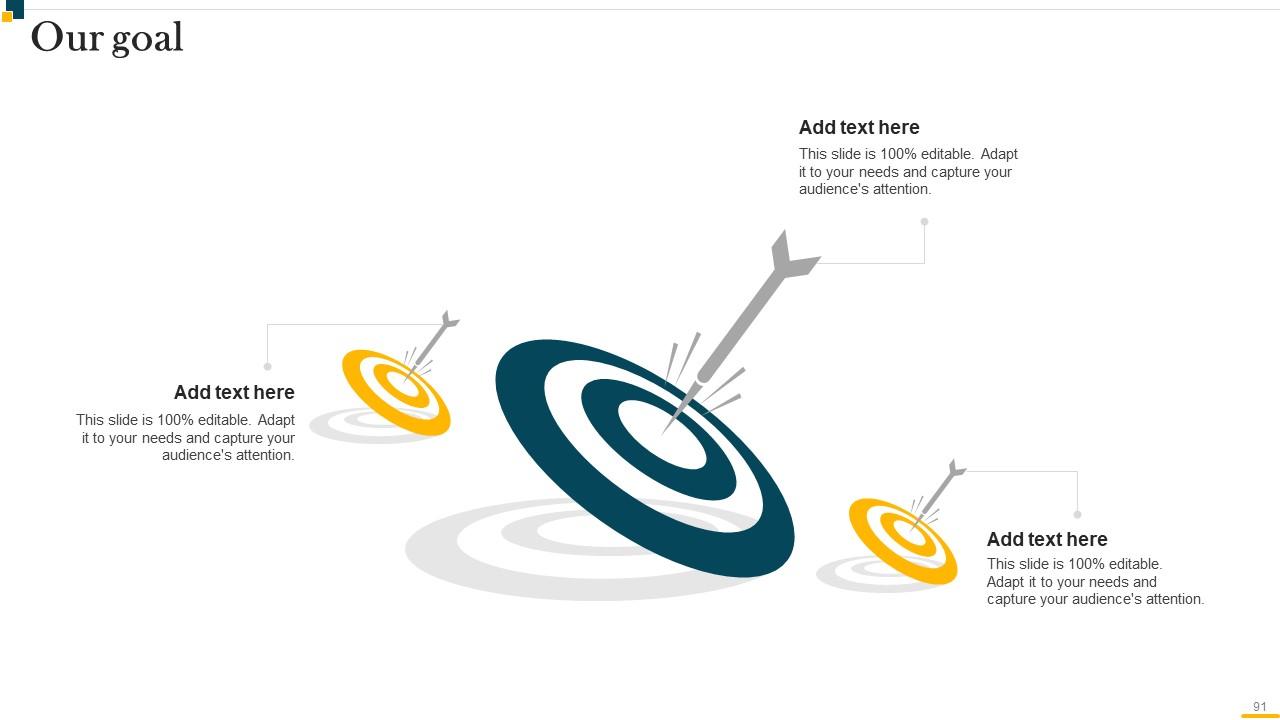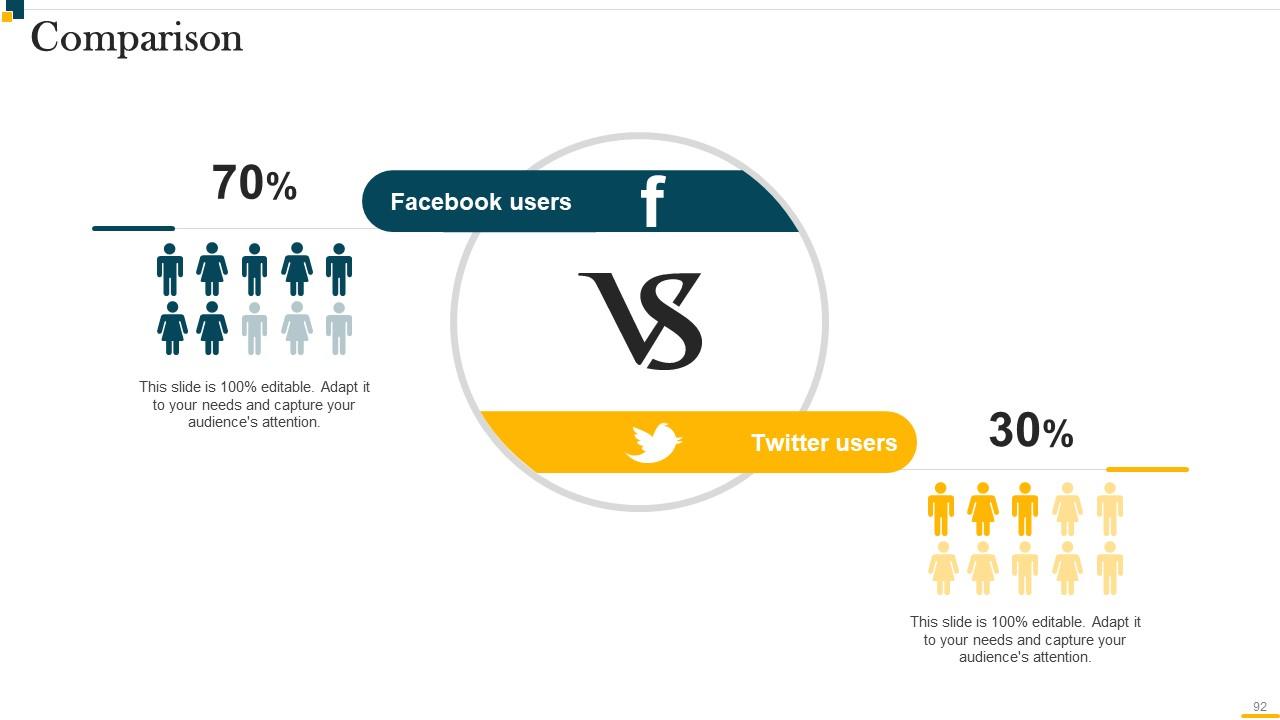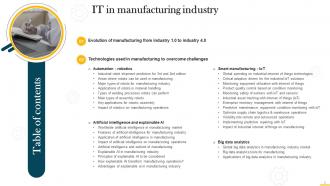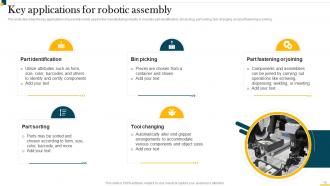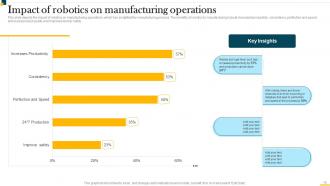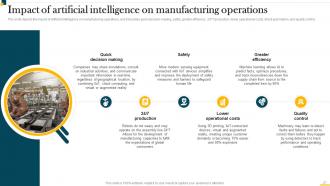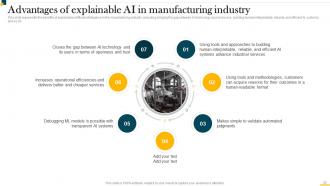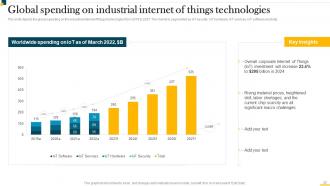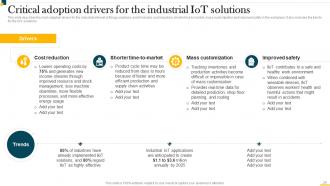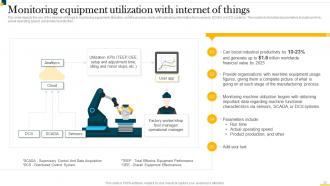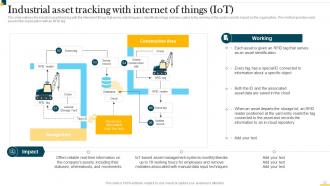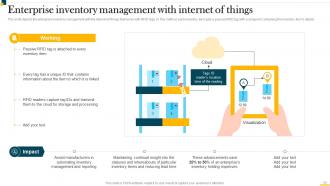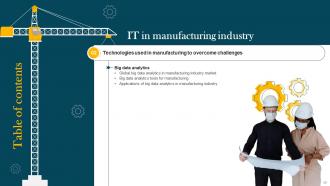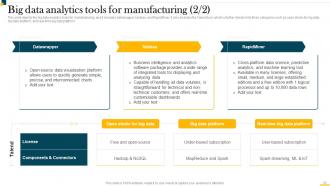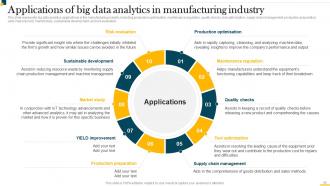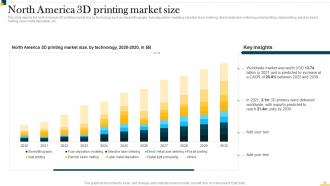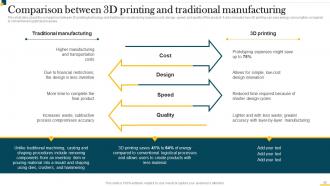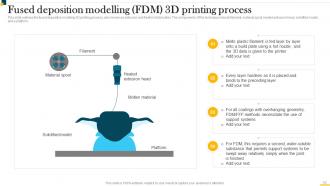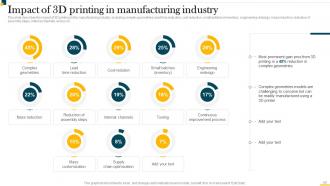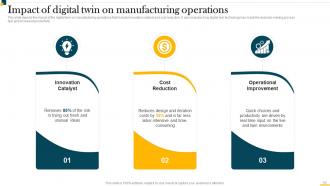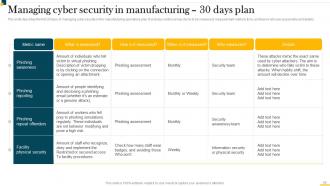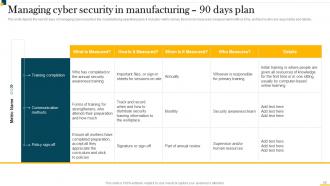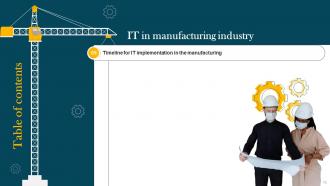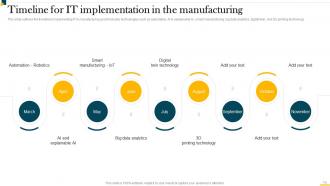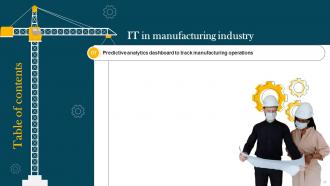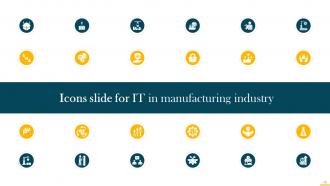IT In Manufacturing Industry Powerpoint Presentation Slides
IT plays a very significant role in the manufacturing industry. Grab our insightfully designed IT in the Manufacturing Industry template. It gives a brief idea about the evolution of the manufacturing industry from 1.0 to 4.0. The PPT includes the technologies used in this industry to overcome production issues. Our AI in manufacturing deck covers the various technologies used in manufacturing industries. These include Automation Robotics, Artificial Intelligence AI, Explainable AI, etc. In addition, the PPT contains the introduction and features of the manufacturing industry. Additionally, our Smart manufacturing module exhibits market size, share, and global spending. It further incorporates application areas, types, impact, working, and safety measures of every technology used. Furthermore, it includes cyber securitys role in smart manufacturing, a 30-60-90 days plan, and a training program for cyber security awareness among employees. Our Smart Manufacturing template caters to the training budget and pricing for technologies used. It also exhibits a timeline and a roadmap to implement IT in the manufacturing industry. Moreover, this IoT in Manufacturing deck comprises a predictive analytics dashboard to track manufacturing operations. Get access now.
IT plays a very significant role in the manufacturing industry. Grab our insightfully designed IT in the Manufacturing Indu..
- Google Slides is a new FREE Presentation software from Google.
- All our content is 100% compatible with Google Slides.
- Just download our designs, and upload them to Google Slides and they will work automatically.
- Amaze your audience with SlideTeam and Google Slides.
-
Want Changes to This PPT Slide? Check out our Presentation Design Services
- WideScreen Aspect ratio is becoming a very popular format. When you download this product, the downloaded ZIP will contain this product in both standard and widescreen format.
-

- Some older products that we have may only be in standard format, but they can easily be converted to widescreen.
- To do this, please open the SlideTeam product in Powerpoint, and go to
- Design ( On the top bar) -> Page Setup -> and select "On-screen Show (16:9)” in the drop down for "Slides Sized for".
- The slide or theme will change to widescreen, and all graphics will adjust automatically. You can similarly convert our content to any other desired screen aspect ratio.
Compatible With Google Slides

Get This In WideScreen
You must be logged in to download this presentation.
PowerPoint presentation slides
This complete deck covers various topics and highlights important concepts. It has PPT slides which cater to your business needs. This complete deck presentation emphasizes IT In Manufacturing Industry Powerpoint Presentation Slides and has templates with professional background images and relevant content. This deck consists of total of ninty three slides. Our designers have created customizable templates, keeping your convenience in mind. You can edit the color, text and font size with ease. Not just this, you can also add or delete the content if needed. Get access to this fully editable complete presentation by clicking the download button below.
People who downloaded this PowerPoint presentation also viewed the following :
Content of this Powerpoint Presentation
Slide 1: This slide introduces IT in Manufacturing Industry. Commence by stating Your Company Name.
Slide 2: This slide depicts the Agenda of the presentation.
Slide 3: This slide incorporates the Table of contents.
Slide 4: This is yet another slide continuing the Table of contents.
Slide 5: This slide highlights the Title for the Topics to be covered next.
Slide 6: This slide depicts the evolution of manufacturing from industry 1.0 to industry 4.0, including the technologies such as steam, hydropower, electrical power, etc.
Slide 7: This slide exhibits the Heading for the Contents to be discussed further.
Slide 8: This slide elucidates the Industrial robot shipment prediction for 3rd and 2nd edition.
Slide 9: This slide represents the areas where robots can be used in the manufacturing process to save time, effort, and money.
Slide 10: This slide illustrates the major types of robots used in the manufacturing industry to make manufacturing processes efficient, time, and money-saving.
Slide 11: This slide outlines the applications of robots in material handling chores, and it includes packaging products, transferring parts, etc.
Slide 12: This slide talks about robotic welding, and because of the diversity of gear available, robots can accommodate a wide range of welding procedures.
Slide 13: This slide discusses the Main types of assembly robots.
Slide 14: This slide describes the key applications of assembly robots used in the manufacturing industry.
Slide 15: This slide highlights the Impact of robotics on manufacturing operations.
Slide 16: This slide elucidates the Heading for the Contents to be discussed next.
Slide 17: This slide focuses on the Worldwide artificial intelligence in manufacturing market.
Slide 18: This slide exhibits the Features of artificial intelligence for manufacturing industry.
Slide 19: This slide focuses on the Application of artificial intelligence in manufacturing.
Slide 20: This slide represents the application of artificial intelligence in the manufacturing industry.
Slide 21: This slide highlights the Impact of artificial intelligence on manufacturing operations.
Slide 22: This slide deals with the Artificial intelligence and outlook of manufacturing.
Slide 23: This slide outlines the use of explainable AI in the manufacturing industry and includes its overview and benefits.
Slide 24: This slide represents the principles of implementing explainable AI in artificial intelligence systems for smart manufacturing, and the system should obey these principles.
Slide 25: This slide describes how explainable artificial intelligence can transform manufacturing operations.
Slide 26: This slide showcases the Advantages of explainable AI in manufacturing industry.
Slide 27: This slide elucidates the Title for the Ideas to be discussed further.
Slide 28: This slide depicts the global spending on the industrial internet of things technologies from 2019 to 2027.
Slide 29: This slide describes the main adoption drivers for the industrial internet of things solutions.
Slide 30: This slide depicts the use of the internet of things in monitoring equipment utilization, and the process starts with collecting information from sensors, SCADA or DCS systems.
Slide 31: This slide represents the product quality control that can be carried out in two ways – by inspecting a work in progress and monitoring the condition and calibration of machines.
Slide 32: This slide focuses on Monitoring safety of workers with IoT and sensors.
Slide 33: This slide outlines the industrial asset tracking with the internet of things that works radio frequency identification tags and also caters to the working of the system and its impact on the organization.
Slide 34: This slide shows the Enterprise inventory management with internet of things.
Slide 35: This slide represents the predictive maintenance and equipment condition monitoring with the internet of things, including its working and impact on the industry.
Slide 36: This slide talks about optimizing supply chain logistics and warehouse operations with the internet of things in the manufacturing industry.
Slide 37: This slide depicts the remote production control with the internet of things.
Slide 38: This slide focuses on Implementing predictive repairing with IoT.
Slide 39: This slide highlights the Impact of industrial internet of things on manufacturing.
Slide 40: This slide showcases the Heading for the Components to be covered further.
Slide 41: This slide describes the global big data analytics in the manufacturing industry market, including CAGR rate, North America's share in the market, year-over-year growth, etc.
Slide 42: This slide represents the big data analytics tools used in the manufacturing industry, including Apache Hadoop, KNIME, Xplenty, and Cloudera.
Slide 43: This is yet another slide continuing the Big data analytics tools for manufacturing.
Slide 44: This slide highlights the Applications of big data analytics in manufacturing industry.
Slide 45: This slide elucidates the Title for the Topics to be discussed next.
Slide 46: This slide depicts the north American 3D printing market size by technology such as stereolithography, fuse deposition modeling, etc.
Slide 47: This slide shows the introduction to 3D printing, also known as additive manufacturing.
Slide 48: This slide talks about the comparison between 3D printing technology and traditional manufacturing based on cost, design, speed, and quality of the product.
Slide 49: This slide presents the working of a 3D printer to make a prototype.
Slide 50: This slide showcases the Stereolithography process of 3D printing.
Slide 51: This slide reveals the digital light processing 3D printing type which is similar to stereolithography.
Slide 52: This slide describes the laser sintering or laser melting 3D printing technique.
Slide 53: This slide outlines the fused deposition modeling 3D printing process, also known as extrusion and freeform fabrication.
Slide 54: This slide talks about the inkjet binder jetting 3D printing process, including its working and benefits.
Slide 55: This slide depicts the inkjet material jetting 3D printing process that uses the materials in liquid or molten form.
Slide 56: This slide describes the selective deposition lamination 3D printing process that builds parts layer by layer on regular copier paper.
Slide 57: This slide represents the materials that can be used in 3D printing for prototype building.
Slide 58: This slide highlights the industrial applications of 3D printing technology in the medical and dental, automotive industry, aerospace, and defence.
Slide 59: This slide elucidates the Impact of 3D printing in manufacturing industry.
Slide 60: This slide incorporates the Heading for the Ideas to be discussed next.
Slide 61: This slide contains the application of digital twin technology in manufacturing industries by depicting the benefits in product design, quality management, process optimization, and predictive maintenance.
Slide 62: This slide showcases the Digital twin technology supply chain management.
Slide 63: This slide depicts the impact of the digital twin on manufacturing operations that include innovation catalyst and cost reduction.
Slide 64: This slide highlights the Title for the Topics to be covered further.
Slide 65: This slide reveals the Role of cyber security in manufacturing automation.
Slide 66: This slide describes the first 30 days of managing cyber security in the manufacturing operations plan.
Slide 67: This slide deals with the next 60 days of managing cyber security in the manufacturing operations plan.
Slide 68: This slide depicts the next 90 days of managing cyber security in the manufacturing operations plan.
Slide 69: This slide outlines the employee awareness training budget for the financial year 2023.
Slide 70: This slide incorporates the Title for the Topics to be discussed in the upcoming template.
Slide 71: This slide displays the training program for technologies used in the manufacturing industry, including automation, artificial intelligence & explainable AI, etc.
Slide 72: This slide talks about the pricing for technologies used in the manufacturing industry, such as automation, artificial intelligence & explainable AI, etc.
Slide 73: This slide lists the Heading for the Components to be covered in the upcoming template.
Slide 74: This slide outlines the timeline to implementing IT in manufacturing and it includes technologies such as automation, AI & explainable AI, smart manufacturing, etc.
Slide 75: This slide highlights the Title for the Ideas to be discussed next.
Slide 76: This slide presents the roadmap to implementing IT in manufacturing and it includes technologies such as automation, AI & explainable AI, smart manufacturing, and many more.
Slide 77: This slide contains the Heading for the Components to be covered in the forth-coming template.
Slide 78: This slide reveals the predictive analytics dashboard to track manufacturing operations, including production volume, order volume, downtime causes, etc.
Slide 79: This is the Icons slide containing all the Icons used in the plan.
Slide 80: The purpose of this slide is to elucidate Additional information.
Slide 81: This slide describes the new business model for service business use case for the internet of things, including its impact on the product and service ratio of the company.
Slide 82: This slide presents the Timeline of 3D printing technologies.
Slide 83: This slide exhibits the Overview of conventional manufacturing process.
Slide 84: This slide represents the challenges with traditional manufacturing systems and it includes the limitation on customization, supply chain disruptions, etc.
Slide 85: This slide shows the Column chart with related imagery.
Slide 86: This is the 30 60 90 days plan for effective planning.
Slide 87: This is the Magnifying glass for minute details.
Slide 88: Thias slide illustrates the Venn diagram.
Slide 89: This slide contains the Post it notes for reminders and deadlines.
Slide 90: This is the Idea Generation slide for encouraging fresh ideas.
Slide 91: This is Our goal slide. List your organization goals here.
Slide 92: This slide is used for the purpose of Comparison.
Slide 93: This is the Thank You slide for acknowledgement.
IT In Manufacturing Industry Powerpoint Presentation Slides with all 97 slides:
Use our IT In Manufacturing Industry Powerpoint Presentation Slides to effectively help you save your valuable time. They are readymade to fit into any presentation structure.
FAQs
IT plays a critical role in optimizing manufacturing processes
IT helps in managing inventory, logistics, and procurement processes in real-time
Some challenges include the high cost of implementation, lack of skilled IT staff, and resistance to change
Automation increases the need for advanced IT systems to control and monitor production processes
Benefits include increased efficiency, better quality control, improved supply chain management, and reduced costs.
-
SlideTeam never fails to surprise me with its amazing PPT designs. Thanks team for providing me with your constant support!
-
I am really satisfied with their XYZ products. Used their slides for my business presentations and now I am taking their help for my son's high-school assignments. Super satisfied!!



